23800吨散货船技术规格书
23800散货船中英文说明
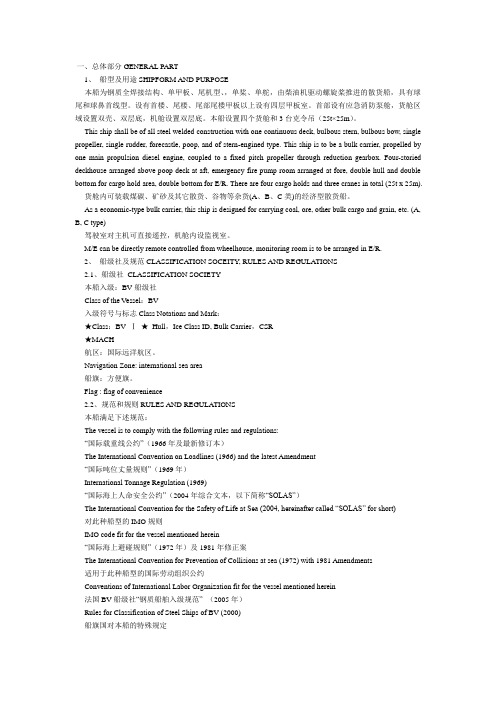
一、总体部分GENERAL PART1、船型及用途SHIPFORM AND PURPOSE本船为钢质全焊接结构、单甲板、尾机型、,单桨、单舵,由柴油机驱动螺旋桨推进的散货船,具有球尾和球鼻首线型。
设有首楼、尾楼、尾部尾楼甲板以上设有四层甲板室。
首部设有应急消防泵舱,货舱区域设置双壳、双层底,机舱设置双层底。
本船设置四个货舱和3台克令吊(25t×25m)。
This ship shall be of all steel welded construction with one continuous deck, bulbous stern, bulbous bow, single propeller, single rudder, forecastle, poop, and of stern-engined type. This ship is to be a bulk carrier, propelled by one main propulsion diesel engine, coupled to a fixed pitch propeller through reduction gearbox. Four-storied deckhouse arranged above poop deck at aft, emergency fire pump room arranged at fore, double hull and double bottom for cargo hold area, double bottom for E/R. There are four cargo holds and three cranes in total (25t x 25m).货舱内可装载煤碳、矿砂及其它散货、谷物等杂货(A、B、C类)的经济型散货船。
As a economic-type bulk carrier, this ship is designed for carrying coal, ore, other bulk cargo and grain, etc. (A, B, C type)驾驶室对主机可直接遥控,机舱内设监视室。
散货船技术规格书
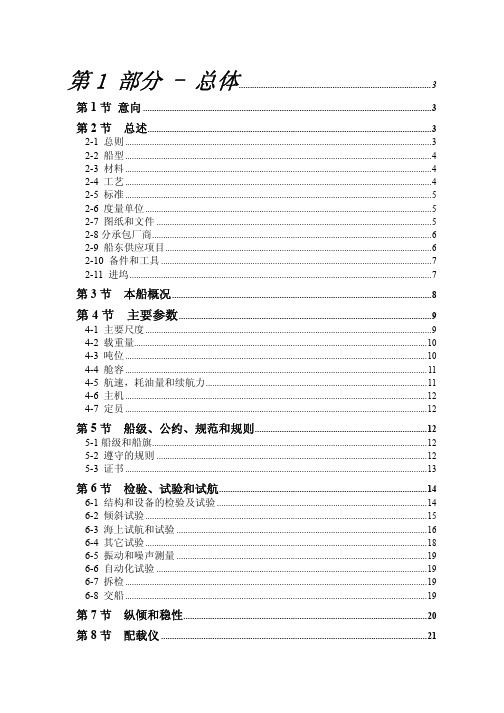
第1 部分 - 总体 (3)第1节意向 (3)第2节总述 (3)2-1 总则 (3)2-2 船型 (4)2-3 材料 (4)2-4 工艺 (4)2-5 标准 (5)2-6 度量单位 (5)2-7 图纸和文件 (5)2-8分承包厂商 (6)2-9 船东供应项目 (6)2-10 备件和工具 (7)2-11 进坞 (7)第3节本船概况 (8)第4节主要参数 (9)4-1 主要尺度 (9)4-2 载重量 (10)4-3 吨位 (10)4-4 舱容 (11)4-5 航速,耗油量和续航力 (11)4-6 主机 (12)4-7 定员 (12)第5节船级、公约、规范和规则 (12)5-1船级和船旗 (12)5-2 遵守的规则 (12)5-3 证书 (13)第6节检验、试验和试航 (14)6-1 结构和设备的检验及试验 (14)6-2 倾斜试验 (15)6-3 海上试航和试验 (16)6-4 其它试验 (18)6-5 振动和噪声测量 (19)6-6 自动化试验 (19)6-7 拆检 (19)6-8 交船 (19)第7节纵倾和稳性 (20)第8节配载仪 (21)第9节船体备品及供应品 (21)9-1备品 (21)9-2 供应品 (22)第1 部分 - 总体第1节意向本技术规格书(以下称规格书)及其所附图纸,旨在阐明一艘单螺旋桨、柴油机驱动、单甲板单壳型远洋散货船的设计、材料、结构和设备。
总布置图、中横剖面图和设备厂商表是规格书的附件及不可分割的组成部分。
规格书及其所附的图纸,两者互为补充。
若建造合同、规格书和总布置图之间存在矛盾或任何不一致时,以建造合同的条款为准。
此外,若规格书和图纸存在矛盾或任何不一致时,以规格书为准。
除规格书中明确规定由船东提供的项目以外,建造方将按照规格书要求完成本船所有项目。
规格书及其附图未说明或未包括,而对本船的安全营运又是所需的任何款项,按照造船惯例,由建造方提供。
第2节总述2-1 总则“船东”和“建造方”是指按建造合同中所详细定义的公司或其代理商。
装船技术规格书
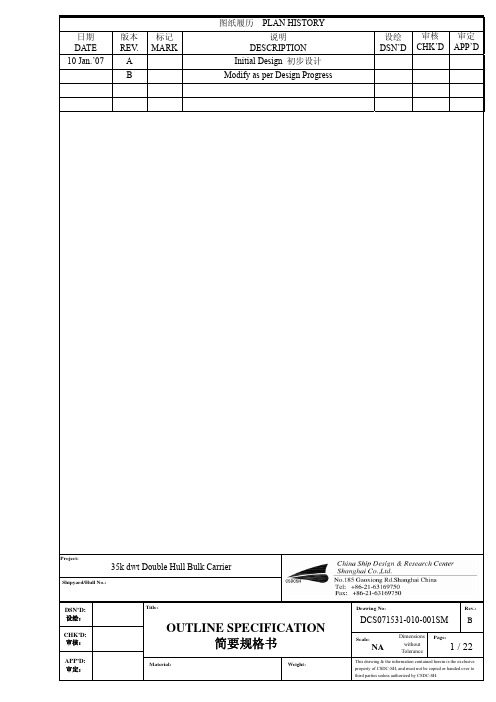
2024年江苏省淮安市小升初数学精选常考应用题自测D卷含答案及解析姓名:________ 考号:________ 得分:________一、应用题(精选150道题;要求一、审题:在开始解答前,应仔细阅读题目,理解题目的意思、数量关系、问题是什么,以及需要几步解答;二、注意格式:正确使用算式、单位和答语;三、卷面要求:书写时应使用楷书,尽量避免连笔,字迹稍大,并注意排版;四、π一律取值3.14。
)1.六年级学生植树,已知成活的是368棵,没成活的是32棵.这批树的成活率是多少.2.一个长方形13分米、宽12分米,这个长方形的周长是多少分米,面积是多少平方分米.3.奥体中心修一段路,平均每天修60米,要18天完成,如要在15天内完成,平均每天要修多少米?4.建筑工地上用的水泥沙是由水泥和沙子按3:8的比拌制而成的.①现要伴制这种水泥沙3吨,各需要水泥和沙子多少吨?②工地上现有水泥600千克,沙子1吨,这些水泥和沙子最多能伴制多少吨这样的水泥沙?③工地上现有水泥600千克,沙子1吨,现要充分地用完这些水泥和沙子,至少还需要运进多少水泥和沙子?至少能伴制多少吨这样的水泥沙?5.甲、乙、丙三人的平均年龄为42岁,若将甲的岁数增加7岁,乙的岁数扩大2倍,丙的岁数缩小2倍,则三人岁数相等.丙的年龄为多少岁.6.一件上衣七五折后售价是135元,这件上衣的原价是多少元?7.机床厂去年生产机床500台,比今年少生产100台.①比今年少了百分之几?②今年比去年多了百分之几?8.五年级有135人,六年级的人数比五年级的4/5多18人,六年级有多少人?9.甲、乙两仓库,甲仓库存粮68吨,乙仓库存粮55.6吨,乙仓库运出多少吨粮食给甲仓库后,甲仓库存粮是乙仓库存粮的3倍.10.学校有一块等腰三角形试验田,在试验田周围围上篱笆,其中两条边长分别是38米和19米.篱笆的总长是多少米?11.运输队去仓库运水泥,第一天运出总数的1/5,第二天运进水泥36吨,这时仓库里的水泥是原来的87.5%,仓库里原有水泥多少吨?12.饲养场养了53只白兔和77只黑兔,养的鸡的只数是兔子的11倍,饲养场养鸡多少只?13.饲养场要运走一批鸡蛋,每箱装50个,已经装了45箱,还剩3000个鸡蛋没有装,这批鸡蛋一共可装多少箱?14.小华家有一块底为40米,高为25米的平行四边形地,共种树480棵,平均每棵树占地面积是多少?15.一个长方形花圃长14米,宽10 米.(1)这个花圃周长多少米?(2)沿花圃四周修一条宽1米的小路、小路面积多大?(先画图分析,再解答)16.五年级两个班为希望工程捐款,1班42人共捐168元,2班45人共捐180元,平均每人捐款多少元?17.植树节那天,五(2)班植树142棵,五(2)班植树棵数比五(1)班的2倍少26棵,五(1)班同学植树多少棵?18.一个长方形面积是480平方厘米,长和宽都是整厘米数,这样的长方形的周长最长是多少厘米,最短是多少厘米.19.有甲、乙、丙三名小学生,甲和乙重83千克,乙和丙重85千克,甲和丙重86千克.请你猜一猜,甲、乙、丙三个人分别有多重?20.五年级同学采集树种128千克,六年级同学采集的是五年级的11/8,四年级同学采集的只有六年级的一半,四年级同学采集树种多少千克?21.一个长方形的面积是256平方厘米,如果长缩小4倍,宽扩大4倍,这个长方形就变成了正方形.这个正方形的面积是多少?它的边长是多少?22.农场有一块三角形试验田,底长160米,高比底短85米.①这块试验田的面积是多少平方米?②农场用这块地的一半种小麦,共收小麦4500千克,平均每平方米收小麦多少千克?23.甲、乙两地相距250米,一辆汽车从甲地开往乙地,行驶了全程的五分之三时,距乙地还有多少千米?24.师徒两人各加工同样多的零件,同时加工,当师傅完成任务时,徒弟还有30个没有完成,当徒弟完成任务时,师傅可以超额完成50个,这批零件总数共多少个?25.植树节同学们要植150棵树,第一天植了1/3,其中的2/5是六年级植的.六年级第一天植了多少棵树?26.东西两城间的路程280千米,甲乙两车分别从两地对开,3.5小时相遇,已知甲车每小时行45.6千米,乙车每小时行多少千米.27.甲乙两辆汽车同时从东站开往西站.甲车每小时比乙车多行12公里.甲车行驶四个半小时到达西站后,没有停留,立即从原路返回,在距离西站31.5千米的地方和乙车相遇,甲车每小时行多少千米?28.同学们要折120只纸鹤,每人折5只,每个小组有12人,需要几个小组才能完成?29.甲乙两车从A城到B城,速度相同.甲车先出发120千米,乙车才出发.甲车到达B城立即返回,在距离B城1/4处相遇到乙车,A、B 两城相距多少千米?30.一个长方体的汽油桶,底面积是16平方分米,高是6分米,如果1升汽油重0.74千克,这个油桶可以装多少千克汽油?31.甲乙两辆汽车同时从两地出发,相向而行,已知甲车每小时行45千米,乙车每小时行35千米,它们在距离中点10千米处相遇,那么,甲乙两地相距多少千米?32.100千克小麦可以磨出面粉85千克,照这样计算,有5000千克小麦,可以磨出多少吨面粉?33.甲、乙两车分别从A、B两地同时开出,相向而行,经过6小时,甲车行了个程的75%,乙车超过中点16千米.已知甲车比乙车每小时多行4千米.求A、B两地相距多少千米?34.学校组织了郊游,需要租车.大客车可以载客50人,每辆需要68元,小客车只能载客39人,每辆只需38元.这次郊游一共去了298人,带队老师只有450元,应该租用哪种车花钱最少?35.体育用品商店迎春节篮球促销:小明带了120元钱,最多能买多少个篮球?(买1~4个,每个26元;买5~9个,每个24元;买10个或10个以上,每个20元.)36.元旦晚会上,六一班同学买来120个气球进行装饰教室,这些气球是红黄蓝三种颜色,个数之比为4:3:1.这三种颜色气球各有多少个?37.甲、乙两个粮仓共存粮95吨,从甲仓调8吨粮食到乙仓,又从乙仓调35吨粮食支援灾区,这时甲仓存粮吨数是乙仓的2倍.求原来甲、乙两仓各存粮多少吨?38.联欢会上,小红按照4个红气球、3个黄气球、2个绿气球的顺序把气球串起来装饰会场,第52个气球的颜色是哪一种?39.一块平行四边形的地,底长180米,高54米,在这块地里植树,平均每棵树占地2.25平方米,这块地可植树多少棵?40.在体育夏令营中,女营员有116人,男营员的人数比女营员的2倍少56人,男营员有多少人?41.妈妈把10000元钱存入银行,已知年利率是7.56%,三年后可领回本息多少元?42.某大型养鸡场把一天产的鸡蛋每25千克装一箱,装好107箱后,还剩19千克,这一天产鸡蛋多少千克?43.商店运来一批苹果,第一天卖了总数的20%,第二天卖了总数的32%,第二天比第一天多卖48千克,这批苹果一共有多少千克.44.师徒两人一共生产了360个零件,师傅生产的零件比徒弟多2倍,师、徒二人各生产了多少个零件?45.商店将进价为每件700元的商品按标价的7折销售,仍可获利21元,商品的标价为每件多少元?46.一根钢管长3米,外直径20厘米,管壁厚2厘米.如果每立方厘米钢重7.8克.这根钢管重多少千克?(得数保留整数)47.同学们沿笔直的操场一侧插彩旗,每隔8米插一面,一共插了26面,从第1面彩旗到最后一面的距离有多远?48.一个圆柱的侧面积是94.2dm2,底面直径是6dm,它的高是多少dm;与这个圆柱等底等高的圆锥形容器的容积是多少L.49.甲、乙、丙三人跳高,成绩分别是90分、94分、98分.a.求出甲、乙两人的平均成绩?b.乙和丙的平均成绩比甲和丙的平均成绩多多少分?c.他们三个人的平均成绩是多少分?50.甲、乙两辆汽车同时从东西两城相对开出,已知甲车每小时行60千米,经过3小时后,甲车已驶过中点30千米,这时甲车与乙车还相距18千米.问此时乙车相距中点多少千米?此时乙车已行多少千米?每小时行多少千米?51.王老师买了5盒彩笔,每盒12枝,发给同学们48枝.还剩多少枝?52.甲、乙两辆汽车同时从AB两站相对开出,第一次在离A站90千米处相遇,相遇后两车继续以原速度行驶,到达对方的出发地后立即返回,第二次相遇在离A地50千米处,求AB两地之间的路程.53.甲、乙两地相距192千米,一辆汽车在上午8时从甲地开出,下午2时到达乙地.这辆车平均每小时行多少千米?54.甲乙两车分别从AB两相对开出,甲车每小时行89千米,乙车每小时行83千米,甲乙两车在距A、B中点30千米处相遇.A、B两地相距多远?55.一批零件.如果单独做.师傅需6小时完成.徒弟需8小时完成、现在两人合作1小时后.正好做了140个零件.这批零件有多少个?56.有63米布,原计划做35件成人上衣,现在用这批布做儿童上衣,每件儿童上衣比成人上衣少用0.2米,最多可以做儿童上衣多少件?57.甲、乙、丙三人,平均体重63千克,甲与乙的平均体重比丙的体重多3千克,甲比丙重2千克,求乙的体重.58.一个圆锥体底面周长是18.84厘米,体积是47.1厘米,圆锥的高是多少立方厘米.59.一个长方形铁片,长37.68厘米,宽15厘米,以它做侧面卷成一个圆柱体,圆柱体的体积最大是多少?60.大山化肥厂前2天生产化肥148.2吨,后3天生产化肥225.6吨,这几天平均每天生产化肥多少吨?61.刘叔叔到化肥厂买化肥,买了168袋化肥,每袋化肥35元,还剩60元钱,刘叔叔一共带了多少钱?62.一批产品的合格率是96%,已知合格产品有192件,不合格产品有多少件?63.A、B两地相距658米,甲、乙两辆汽车分别从A.、B两地同时相向而行,经过6.25小时后相遇,甲车的速度是每小时45.5千米,乙车的速度是每小时多少千米?64.一块正方形地,边长8米,面积是多少平方米.如果在这块地的四周围上篱笆,篱笆长是多少米.65.某实验小学五年级408人去秋游,小客车限载乘客25人,每天每辆600元,大客车限载乘客40人,每天每辆800元,问怎样租车合算?66.甲、乙两车同时从相距348千米的两地同时出发相向而行,4小时相遇,相遇时甲车行了180千米,乙车每小时行多少千米?67.仓库原有货物56吨,今天运走了9车,如果每车运c吨,那么仓库里还剩货物多少吨?68.建筑工地有一个圆锥形沙堆,底面周长是6.28米,高是1.5米.如果用容积是0.3立方米的车子把这堆沙运走,至少要运几次?69.商店运进250只红气球和一些黄气球,红气球卖出50只以后,剩下的只数是黄气球的2倍,商店运进黄气球多少只?70.六年级有男生22人,女生比男生少2/11,全班有多少人?71.某校参加数学竞赛有120名男生,80名女生,参加语文竞赛的有120名女生,80名男生,已知该校总共有260名学生参加竞赛,其中75名男生两科竞赛都参加了,那么只参加数学竞赛而没有参加语文竞赛的女生有多少人?72.甲、乙两地相距250千米,一辆汽车从甲地开出,平均每小时行50千米,几小时可以到达乙地?73.甲每小时跑14.4千米,乙每小时跑10.8千米,乙比甲多跑了2分钟,结果比甲少跑了120米,那么甲跑了多少米.74.在夏令营活动中,1000名同学一天能吃7.6千克盐,照这样计算10名同学一天要吃多少千克盐?合多少克?75.“六一”节时,同学们按“红黄红红蓝黄”的规律在教室里挂上了许多气球,第20个气球是什么颜色的,第57个气球是什么颜色的.76.东方小学组织学生乘同样的大巴去旅游,低年级的师生坐满14辆大巴还剩下35人,剩下的与高年级师生一起刚好坐满11辆大巴,已知低年级师生是全校师生总数的7/12,东方小学参加旅游的师生有多少人?每辆大巴乘坐多少人?77.甲乙两辆汽车同时从相距270千米的两地相对开出,经过1小时30分后两车相遇.已知乙汽车与甲汽车的速度比是7:8,求这两辆汽车每小时各行了多少千米?78.六年级某班某天有116名学生出勤,3名学生病假,1名学生事假.出勤的学生人数占全班总人数的多少百分数?79.一辆客车和一辆货车分别从溧水和上海两地沿着高速公路同时相对开出,1小时后两车相距154千米.已知客车行完全程要4小时,货车行完全程要5小时,问溧水到上海的高速公路全长多少千米?80.食堂运来一批花生油,如果每天用1.8千克,能用160天.如果每天节约0.3千克,能用多少天?81.工人叔叔做零件,前3天每天做125个,后4天每天做160个,一星期工人叔叔做零件多少个?82.学校组织三年级同学去春游,准备了9箱矿泉水,每箱24瓶,如果把它们平均分给2个班,每班可分得多少瓶?83.师徒二人加工一批零件,师父每小时加工45个,徒弟每小时加工28个,师徒二人一天(按8小时计算)共加工多少个零件?(用二种方法解答)84.建筑工地要运黄砂100吨,用一辆载重4吨的汽车运了10次,剩下的改用一辆载重2.5吨的汽车运,还要运几次?(列方程解)85.一个车间,平均每个工人每天加工零件144个,5个工人25天加工零件多少个?86.甲乙两辆汽车分别从AB两地相对而行,3小时后两车相遇,这时甲乙两车所行路程的比是7:5,甲比乙多行24千米,AB两地相距多少千米?87.东西两城相距254千米,甲、乙两辆汽车相对开出,甲车每小时行27千米,先行2小时后,乙车开始出发,速度为每小时23千米.乙车出发几小时后两车相遇?88.甲、乙两个箱子共装了300多个零件,如果从甲箱取出a个放到乙箱中,甲箱比乙箱的零件数少4/13;如果从乙箱取出a个放到甲箱中,乙箱比甲箱的零件数少2/9.那么原来甲箱乙箱中各有多少零件?89.甲、乙两地公路长392千米,一辆汽车从甲地出发开往乙地,前2小时行了112千米,照这样的速度,还要几小时才能到达乙地?(用比例解)90.100克花生仁可以榨出42克花生油.照这样计算,3.5吨花生仁可以榨出多少吨花生油?(用比例解)91.一本书共有144页.女孩8天就看完了.男孩准备12天看完,女孩比男孩平均每天多看多少页?92.六一儿童节同学们做彩花装扮教室.蓝花30朵,黄花是蓝花的2倍,红花比蓝花和黄花的总数多10朵,他们做了多少朵红花?93.一个长方形花坛,长106分米,宽8米,它的周长是多少分米,面积是多少平方分米.94.一桶油,第一次取出这桶油的35%,第二次再取15千克就刚好剩下这桶油的一半,这桶油一共重多少千克?95.一桶油连桶带油共重126千克,售出一半后的重量为71千克,如果每千克售价6元,这桶油共可卖多少元?96.学校要挖一个半径10米、深2.5米的圆柱形喷水池,并且在它的周围安上铁栅栏。
80000吨级巴拿马散货船简要规格书
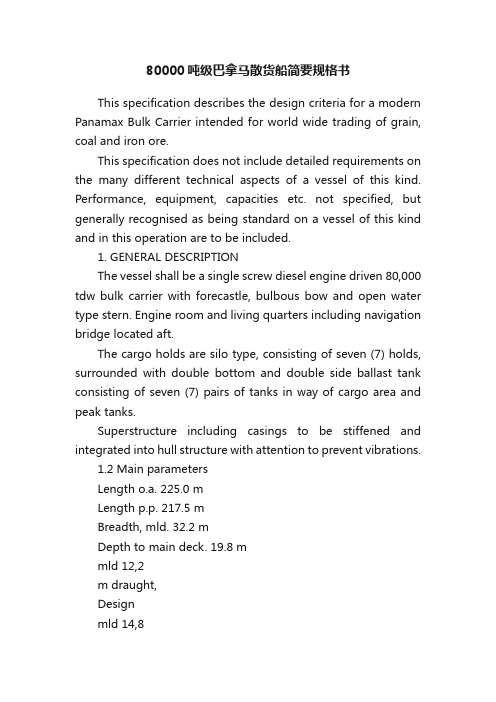
80000吨级巴拿马散货船简要规格书This specification describes the design criteria for a modern Panamax Bulk Carrier intended for world wide trading of grain, coal and iron ore.This specification does not include detailed requirements on the many different technical aspects of a vessel of this kind. Performance, equipment, capacities etc. not specified, but generally recognised as being standard on a vessel of this kind and in this operation are to be included.1. GENERAL DESCRIPTIONThe vessel shall be a single screw diesel engine driven 80,000 tdw bulk carrier with forecastle, bulbous bow and open water type stern. Engine room and living quarters including navigation bridge located aft.The cargo holds are silo type, consisting of seven (7) holds, surrounded with double bottom and double side ballast tank consisting of seven (7) pairs of tanks in way of cargo area and peak tanks.Superstructure including casings to be stiffened and integrated into hull structure with attention to prevent vibrations.1.2 Main parametersLength o.a. 225.0 mLength p.p. 217.5 mBreadth, mld. 32.2 mDepth to main deck. 19.8 mmld 12,2m draught,Designmld 14,8m Scantlingdraught,Deadweight at design draught 64.000 mt Deadweight at scantling draught 80.000 mtSpeed at moulded scantling draught Approx. 14.5 knots Endurance. Approx. 21.000 sea miles Accommodation for 26 man + 6 Suez crewClass : Det Norske Veritas + 1A1, Bulk Carrier, ESP, HC-E (2 and 5 empty), NAUTICUS (Newbuilding), E0,Flag : NIS or Bahamas (for design/outfitting purpose)1.3 Basis operational criteriaThe vessel is intended for the carriage of dry bulk cargoes and shall be designed as silo type with high grade of self trimming in carriage of grain, coal and iron ore cargoes.The hatch cover arrangement shall be of ''open hatch type'' giving 100 % grab access to the cargo hold flat bottom area.Cargo holds to be designed for a free fall loading rate 16,000 t / h, and strengthened for 50 tons grab discharge1.4 Pollution prevention and Environmental protectionThe vessel is designed in accordance with DNV class notation Clean in order to make the vessel suitable for all trades requiring a highly safe and “environmentally friendly” vessel. Change of ballast water during voyage to be possible under moderate sea conditions.For collection of deck water during tropical rainfall, two (2) rainwater collection tanks to be provided on each side of aft cargo, tank capacity 1.0 mm rain on cargo deck during a 10 min period.HFO and Diesel oil tanks to be protected by cofferdam/ballast tank against seaA sewage treatment plant of gravity type sewage system, sized for 28 persons.Garbage disposal arrangement, consisting of a garbage collection room, with facilities for garbage separation and removal in containers to shore.1.5 Cargo and ballast tank capacitiesCargo hold capacity (including the coaming dome) shall be min. 91.800 m3.The ballast tank capacity shall be min 34.000 m3 and to comply with MARPOL and Panama Canal Regulations.Other tank capacities :Fuel oil tanks including settling & service tanks abt. 2.100 m3 Diesel oil tanks including service tank abt. 150 m3Fresh water tanks (potable) abt. 400 m32. CARGO HOLD AND DECK ARRANGEMENT2.1 Cargo holdsThe cargo holds shall consist of seven (7) silo type holds. The transverse bulkhead of vertically corrugated plating, having stools at top and bottom. Side bulkheads are plane, with structural members inside ballast tanks.The cargo holds to be strengthened for grab discharge with grabs up to 50 tons.The entrance to cargo holds to be from open deck, through an access trunk at transverse stools, and thereafter by spiral ladders inside double corrugation in the bulkhead.2.2 Hatch coversThe hatch covers on cargo holds to be of side rolling type designed for a 21,0 x 15 8 m free opening.The forward hatch cover to be for a hatch opening 20,0 x 15.50/10,5 m.The hatch covers to be hydraulically operated and provided with hydraulic cleats.2.3 Windlass and Mooring winchesHydraulic powered windlass and mooring winches without automatic tension- two sets of combined windlass / mooring winches, each with cable lifter, two 20 tonsmooring drums and one warping end- six sets of mooring winches, each with two 20 tons drums and warping end2.4 Cargo hold bilge arrangementFor bilge arrangement and stripping operations during hold cleaning, each cargo hold to be provided with 2 (two) stripping ejectors, operated with water from the general service pump. The ejector and piping arrangement to be located in one closed bulkhead corrugation.Bilge well opening to cargo hold to be provided with bolted hatch.2.5 Cargo tank cleaning arrangementAt least two (2) tank cleaning machines to be provided for each cargo tank, located in the upper transverse stool, retractable type, stored inside the stoolThe cleaning machines shall be supplied with seawater from operation by the general service pump, provided with a suction from ME cooling water outlet, enabling cleaning with up to 45 degC hot water4. MACHINERY ARRANGEMENTThe engine room installations, monitoring, alarm and remote controls shall be equippedand installed in accordance with classification societyrequirements for unattended engine room arrangement, DNV’s class notation E0.4.1 Main engine and propulsion arrangementOne MAN B&W or SULZER, two stroke, single acting, direct reversible cross head marine diesel engine with exhaust gas turbocharger and auxiliary blower.The propulsion arrangement to be sufficient to give the vessel a speed of 14.5 knots at90 % MCR with 15% sea margin4.2 Auxiliary diesel enginesThree (3) Auxiliary engines, four stroke, single acting, direct injection marine dieselengine equipped with exhaust gas turbocharger :Type : WARTSILA 5L20, or equivalentMCR : 775 KWRPM : 900One emergency diesel engine set with a capacity of abt. 180 KW at 440 V, AC, 60 Hzto be arranged in a separate room outside the engine room.4.3 Steam production plantFor steam production for HFO heating and internal hot FW use, one (1) combined exhaust boiler capacity 4.0 tons / h, working pressure 8 bar to be provided5. SAFETY EQUIPMENT AND FIRE PROTECTIONThe vessel to be equipped with all appliances necessary to comply with applicable regulations of flag state administration, classification requirements and USCG regulations for foreign flag vessels.5.1 Safety equipmentOne (1) free fall lifeboat for 28 persons to be provided.One (1) rigid fibre glass MOB / rescue boat with single-point launching, capacity 6 persons with an outboard engine of abt. 40 HP.Four (4) inflatable rafts aft, each for 14 pers.One (1) inflatable raft for 6 men forward.Life-buoys, life-jackets and other lifesaving equipment for 28 persons5.2 FireProtectionThe fire protection and execution shall be in compliance with SOLAS 2001 including latest amendments and to consist of : - Fire detection and alarm systems for ER and accommodation- Fire and deck-wash line with hydrants on main deck- Portable dry powder fire extinguishers on cargo deck- Fire hydrants in engine room and accommodation- CO2 smothering for ER- Fixed local water mist system incl. pumps in ER- Portable fire extinguishers in accommodation.- One (1) Fire / deck wash and general service pump, cap. acc. to rules.- One (1) Fire pump, cap. acc. to rules.- One (1) Emergency fire pump, cap. acc. to rules6. NAVIGATION AND COMMUNICATION EQUIPMENTNavigation and communication equipment, bridge arrangement and layout shall be designed with the object of maximum visibility and functional efficiency.The bridge shall be of integrated design containing the following equipment :6.1 Navigation equipment and systems :- Two (2) radars, one 3 cm and one 10 cm rasterscan radar, with color monitor.One radar with ARPA. Interswitch.- DGPS system- Conning display- Watch monitoring and alarm transfer system- Two (2) Gyro-compass with repeaters- Auto-pilot- Automatic Identification System- Magnetic compass- Echo-sounder- Doppler type speed log- Anemometer6.2 Radio and Communication systems- One (1) radio station to be arranged and equipped in accordance with GMDSSfor world wide trading (A3 areas).- One (1) Satellite communication plant FLEET 77, class 4, with telephone,high-speed data possibility and facsimile services- Two (2) Satellite communication plant INMARSAT Fleet- Mobile telephone GSM system, with fax and e-mail- One (1) MF/HF Single-Side-Band Duplex Radio station, 250 W PEP,with DSC facility and mast antennae- Navtex with printer- Weatherfax- Emergency radio equipment (for lifeboats etc.) according to authorities' requirements - EPIRB, free float type- Two (2) VHF with Digital Sell-Call units (DSC), 55 channels- Five (5) intrinsically safe UHF portable on-board communication sets, 8 channels 7. ACCOMMODATION Accommodation to be arranged for 26 persons including pilot plus 1 hospital and6 Suez crew in a 6-berth cabin. Single berth cabins with private bathroom for all officers and crew as follows : Ranking No of cabins DescriptionCaptain class 2 Dayroom, bedroom & private bath / toilet Senior officers 2 Single cabin & private shower / toilet Junior officers 7 Single cabin & private shower / toiletCrew class 15 Single cabin & private shower / toiletSuez crew 6 One cabin with shower / toilet。
船体技术规格书(内页)
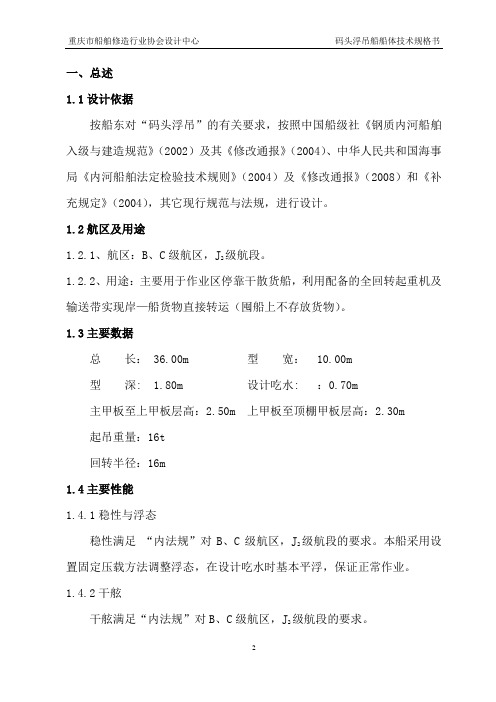
一、总述1.1设计依据按船东对“码头浮吊”的有关要求,按照中国船级社《钢质内河船舶入级与建造规范》(2002)及其《修改通报》(2004)、中华人民共和国海事局《内河船舶法定检验技术规则》(2004)及《修改通报》(2008)和《补充规定》(2004),其它现行规范与法规,进行设计。
1.2航区及用途1.2.1、航区:B、C级航区,J2级航段。
1.2.2、用途:主要用于作业区停靠干散货船,利用配备的全回转起重机及输送带实现岸—船货物直接转运(囤船上不存放货物)。
1.3主要数据总长: 36.00m 型宽: 10.00m型深: 1.80m 设计吃水: :0.70m主甲板至上甲板层高:2.50m 上甲板至顶棚甲板层高:2.30m起吊重量:16t回转半径:16m1.4主要性能1.4.1稳性与浮态稳性满足“内法规”对B、C级航区,J2级航段的要求。
本船采用设置固定压载方法调整浮态,在设计吃水时基本平浮,保证正常作业。
1.4.2干舷干舷满足“内法规”对B、C级航区,J2级航段的要求。
1.5试验本船材料试验、密性试验、倾斜试验按中国船级社《钢质内河船舶入级与建造规范》(2002)及GB/T3035—2005“船舶倾斜试验”标准的要求进行。
二、总体布置[详见“总布置图”]2.1舱底尾部布置艉尖舱、锚链舱、泵舱、空舱;中部为压载舱;首部布置艉尖舱、锚链舱、空舱等。
2.2主甲板尾部#0~#10为锚泊和系泊作业区及上楼钢质楼梯,#10~#18靠岸一侧布置配电间;靠江一侧布置下舱钢质楼梯、厨房、浴厕等;中部为起重作业区及输送货物区域;首部为锚泊和系泊作业区。
2.3上甲板布置船员室单人间8间。
2.4顶逢甲板布置有桅杆、重力水箱、船名灯箱及灯光信号设备。
三、船体结构本船为单甲板、单底、单舷侧钢质全电焊结构。
3.1结构形式本船为横骨架结构形式。
3.2起重机与船体连接(见起重机安装图)起重机底座采用圆筒结构(为厂家按起重机规范要求设计生产的成品)起重机园筒底座直接焊接于船底板上,船体纵横舱壁从四个方向与园筒体焊接连接,园筒体穿过强力甲板处与强力甲板焊接连接,且在强力甲板上、园筒体周围加设φ3500×10的复板,复板与强力甲板、园筒底座有效焊接。
大型船舶尺寸和吃水深度数据信息

杂货船设计船型尺度船舶吨级设计船型尺度〔 m〕DWT 〔 t〕总长L型宽 B型深H满载吃水 T 1000〔 1000~1500 〕862000〔 1501~2500 〕873000〔 2501~4500 〕1081686 5000〔 4501~7500 〕12510000〔 7501~11500 〕15015000〔11501~16500 〕1592320000〔16501~22000 〕1661430000〔22001~35000 〕18111 40000〔35001~55000 〕198注:① DWT系指船舶载重量(t〕;②多用途码头设计船型尺度可按相应吨级的杂货船设计船型尺度选用。
散货船设计船型尺度船舶吨级设计船型尺度〔 m〕DWT 〔 t〕总长L型宽 B型深H满载吃水 T 10000〔 7501~12500 〕1362115000〔12501~17500 〕1532320000〔17501~22500 〕1642535000〔22501~45000 〕19050000〔45001~65000 〕2251813 70000〔65001~85000 〕230100000〔85001~105000 〕25043120000 〔 105001~135000 〕26643150000 〔 135001~175000 〕28924200000 〔 175001~225000 〕31250250000 〔 225001~275000 〕326原油船设计船型尺度船舶吨级设计船型尺度〔 m〕DWT 〔 t〕总长L型宽 B型深H满载吃水 T 1000〔1000~1500 〕702000〔1501~2500 〕863000〔2501~4500 〕961575000〔4501~7500 〕1167 10000〔7501~12500 〕13120000 〔12501~27500 〕1641030000〔27501~45000 〕1863250000〔45001~65000 〕22980000〔65001~85000 〕24342100000〔85001~105000 〕247120000 〔 105001~135000 〕2654616 150000 〔 135001~185000 〕27548250000 〔 185001~275000 〕33359300000 〔 275001~375000 〕33459集装箱船设计船型尺度船舶吨级设计船型尺度〔 m〕DWT 〔 t〕总长L型宽 B型深H满载吃水 T 1000〔1000~2500 〕903000〔2501~4500 〕1065000〔4501~7500 〕12110000〔7501~12500 〕14720000 〔12501~27500 〕18330000 〔27501~45000 〕24412 50000 〔45001~65000 〕29413 70000 〔65001~85000 〕30014 100000 〔 85001~115000〕347注: TEU系指 20英尺国际标准集装箱。
3000吨船体说明书
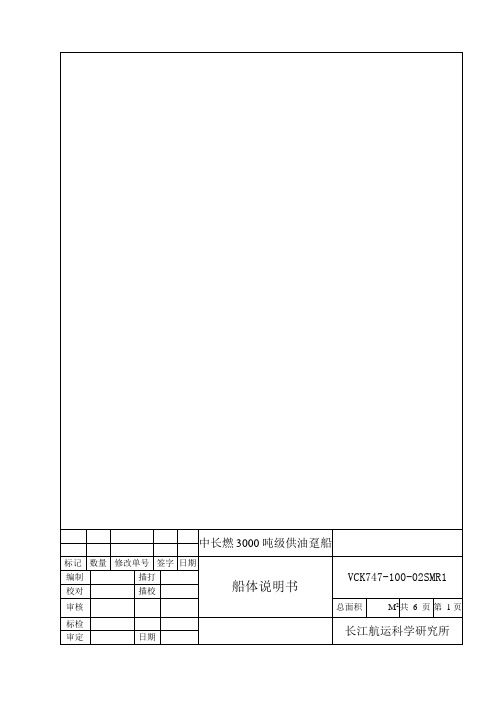
一、全船技术要求说明1.规范及规则本船满足下列规范、规则,包括直至签约之日为止所有修改通报和修改案的适用部分:(1)CCS《钢质内河船舶入级与建造规范》;(2)中国海事局《内河船舶法定检验规则》;(3)CCS颁布的其它适用的有关规范、规则和规程。
2.检验和证书本船设计、建造、试验、交船,采用的材料、产品、设备等,由CCS实施检验,在交付使用时,应取得营运证书。
除此之外,交船时尚应取得工厂建造、产品检验、设备使用等方面的证书及有关资料。
3.试验与交船本船所有车间试验、船体密性试验、倾斜试验及系泊试验等,均按CCS有关规范的要求进行试验和检验,并提交由CCS认可的各种试验报告和检验合格证书。
本船在完成各项试验、各项系统装置设备运转正常、各项性能指标达到技术要求,船舶符合建造合同规定,方能交船。
二、用途、航区本船为内河储油趸船,航区为内河A级。
该趸船装载、销售闪点>60℃(闭杯试验)的柴油、燃料油,液货舱容积可保证油品装载量约3000吨。
三、船型及主尺度1.本船为方箱、首尾部削斜船型,采用单甲板、单底双舷结构全电焊钢质趸船。
2.主要尺度总长 90.00 米型宽 18.00 米型深 3.80 米吃水 2.70 米肋距 0.60 米梁拱 0.20 米主甲板舱室高 3.10 米总吨 1968净吨 1653四、总布置1.主甲板以下本船主甲板下在#12、#25、#49、#73、#97、#117、#137、#140肋位设置八道水密横舱壁,在#25~#140肋位之间设置一道舯纵水密舱壁,在#25~#137肋位之间左右设置两道水密纵舱壁。
从尾~首依次分隔为尾尖舱(左污油水舱、右清水舱)、机泵舱、#5(左右)柴油舱(燃料油舱)、#4(左右)柴油舱(燃料油舱)、#3(左右)柴油舱(燃料油舱)、#2(左右)柴油舱、#1(左右)柴油舱、隔离舱、首尖舱。
2.主甲板上尾~#12肋位:为尾锚泊系泊操作区。
首#137~#150肋位为首锚泊操作区。
23800吨散货船技术规格书讲解

23800吨散货船技术规格书1.总则1.1 本船轮机部分技术设计按23800DWT货船设计任务书要求,并满足法国船级社(BV)《钢质船舶入级规范》有关要求以及其他有关国际航行船舶的政府规定。
1.2 本船推进装置型式为单机单桨,主机为低速二冲程柴油机经中间轴和尾轴直接传动螺旋桨。
1.3 本船主要装载煤炭等大宗杂货。
1.4本船各机械设备及管系附件均按中国工业标准(如GB、CB、JB、YB等)制造,但进口设备附带的附件及管系等按制造厂标准。
1.5各机械设备的备品供应按船级社规范和船东要求配置。
1.主要设备的配置2.1 主机 1台型号:MAN-B&W 7S35MC型式:二冲程,单作用涡轮增压,直流扫气,十字头式,可直接换向船用柴油机缸数:6缸径/行程:350/1400mm最大持续功率(MCR):5180kW转速:173r/min燃油消耗率:178g/kW·h+5%起动方式:压缩空气(最大压力2.94MPa)2.2主柴油发电机组 3组机组型号:CCFJ465J2.2.1 柴油机型号:MAN-B&W 5L16/24型式:直列,四冲程,直接喷射增压中冷船用柴油机缸数:5缸径/行程:160/240mm额定转速:1200r/min燃油消耗率: 189g/kW·h起动方式:压缩空气冷却方式:水冷2.2.2 发电机型号:1FC6 454-6型式:船用三相交流同步发电机额定功率:465kW额定转速:1200r/min电压:450V频率:60Hz2.3 应急柴油发电机组 1组机组型号:CCFJ120Y-W6额定功率:120kW电压:450V频率:60Hz2.4 燃油/废气组合锅炉型号:LZY0.8/140-0.7蒸汽压力:0.7Mpa蒸发量:燃油部分:~800kg/h废气部分:~650 kg/h注:2台锅炉给水泵由锅炉厂配套供应3 轴系3.1本船主机为刚性固定,采用环氧树脂垫块进行安装。
散货船改造技术说明书
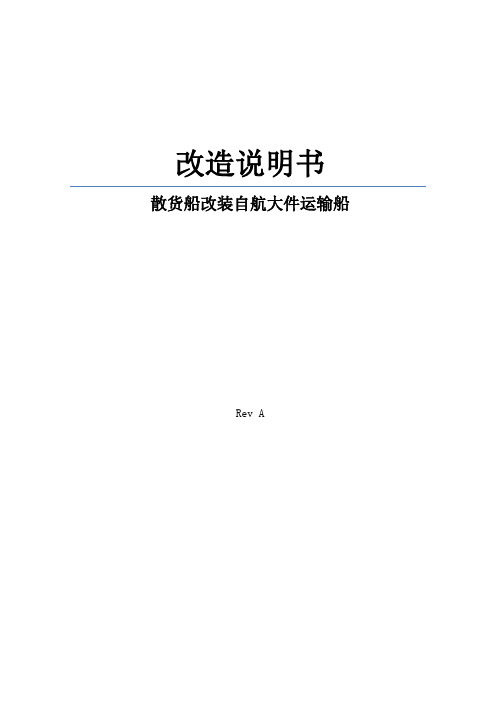
改造说明书散货船改装自航大件运输船Rev A目录I总体部分 (6)第 1 节总述 (6)1.1 概述 (6)1.2 本船概貌 (6)第 2 节船级、规范、规则和证书 (7)2.1 船级 (7)2.2 规范和规则 (7)2.3 证书 (8)2.4 船旗国 (8)第 3 节改装后主要参数 (9)3.1 主要尺度 (9)3.2 载重量 (9)3.3 容积 (9)3.4 主机和螺旋桨 (9)3.5 航区 (9)3.6 定员 (9)Ⅱ船体部分 (10)第1节船体总述 (10)1.1 布置 (10)1.2 干舷 (11)1.3 纵倾和稳性 (11)1.4 结构试验 (11)第 2 节船体结构 (11)2.1 货舱区域主船体改造 (11)2.2 首尾部结构 (12)2.3 杂项 (13)第 3 节舾装设备 (13)3.1 锚和系泊设备 (13)3.2 舵设备 (14)3.3 桅与起重设备 (14)3.4 救生设备和吊艇架 (14)3.5 舱盖和人孔盖 (14)3.6 梯 (15)3.7 栏杆及扶手 (15)3.8 帆布制品 (15)3.9 杂项 (15)第 4 节甲板机械 (16)第 5 节舱室 (16)5.1 舱室布置 (16)5.2 舱室基本配置 (16)5.3 舱室绝缘,敷料和内装 (17)5.4 门与窗 (17)第 6 节油漆和阴极保护 (17)6.1 表面处理 (17)6.2 油漆 (17)6.3 油漆备品 (18)6.4 阴极保护 (18)IV 轮机部分 (19)第 1 节基本改装设计要求 (19)1.1 概述 (19)1.2 设计条件 (19)1.3 检验和试验 (20)1.4 燃油 (21)2.1 主机(不变) (21)2.2 发电机组(不变) (21)2.3 蒸汽发生装置 (22)2.4 压载泵组(新增一台压载泵) (22)2.5 压载水处理装置(新增一套) (22)2.6 油水舱柜(重新分隔) (22)第 3 节轴系 (22)第 4 节机舱系统及布置 (22)4.1 机舱系统 (22)4.2 机舱布置 (23)第 5 节全船系统 (23)5.1 压载水系统 (23)5.2 舱底水系统 (24)5.3 消防系统 (24)5.4 全船疏水、生活污水系统 (25)5.5 空气、测深和注入系统 (25)5.6 舱室通风 (25)5.7 全船供水系统 (25)V 电气部分 (26)第 1 节配电 (26)1.1 主配电板 (26)1.2 分配电箱及变频变压设备 (26)1.3 压载控制台 (26)1.4 起动器 (26)1.5 电源接口 (27)第 2 节照明系统及主照明变压器 (27)2.1 舱室照明 (27)2.2 障碍灯及风向袋 (27)2.3 探照灯障碍灯及风向袋 (27)2.4 插座 (27)2.5 主照明变压器 (27)第 3 节罗经甲板和驾驶室增加的设施 (27)第 4 节船内通信系统 (28)4.1 广播扬声器 (28)4.2 程控电话及声力电话 (28)第 5 节航行及无线电设备 (28)5.1 无线电设备 (28)5.2.雷达系统 (28)5.3 电子海图系统 (28)5.4 电罗经系统 (28)5.5 首瞭望室 (28)I 总体部分第 1 节总述1.1 概述本说明书和附属的图纸是用以说明及表达将一艘散货轮改装为可装运大型集装箱桥吊(滚装滚卸)以及大型(重型)货物的运输船所需的材料和工作。
23000吨散货船船体说明书
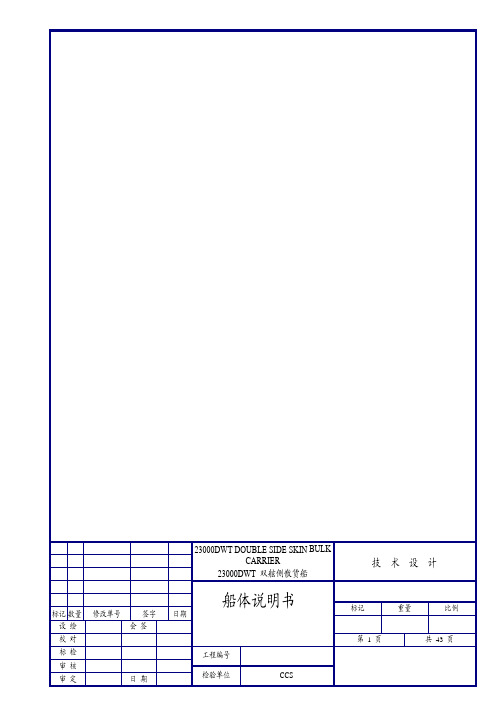
8000吨多货船技术规格书 07[1].06.06A
![8000吨多货船技术规格书 07[1].06.06A](https://img.taocdn.com/s3/m/018b7a0314791711cc7917ab.png)
船东代表:承造厂代表:编 制打 字8000吨干货船校 对 图号审 核 共 51 页 第 1 页审 定技术规格书重庆东风船舶设计研究所目 录Ⅰ 总 则 (3)Ⅱ 船体部分 (12)Ⅲ 轮机部分 (16)Ⅳ 电气部分 (366)Ⅰ 总 则1.1船舶总体1.1.1 总述1.1.1.1用途和航区本船系一艘装运干杂货的干货船。
航行国际航线,无限航区。
本船按中国CCS《钢质海船入级规范》(2006年)及(2007年)修改通报,中国海事局《国际航行海船法定检验技术规则》(1999年)及修改通报的规定要求进行设计,结构满足B级冰区要求加强。
1.1.1.2船型本船为钢质、双甲板、艉机型、单桨、单舵,由柴油机驱动固定螺旋桨推进的干货船,具有球鼻艏线型。
设有艏楼。
艉部上甲板以上设有甲板室。
货舱区域设双底、双壳、双层底舱用作压载水舱、燃油舱。
1.1.2 船级、规范、规则和证书1.1.2.1 船级本船入中国CCS船级,并取得如下入级符号:★CSA General dry Cargo Ship, ice class B; ★CSM 附加MCC本船悬挂香港旗。
1.1.2.2 规范和规则本船设计满足CCS在船舶建造合同签订之日已生效的规范和中国政府认可的有关国际公约、规则及修正案的要求,包括以下公约、规范、附则及相关修正案:1)1969国际吨位丈量公约2)1966国际载重线公约3)73/78防污公约4)1974国际海上人命安全公约及修正案5)国际海上避碰规则(1972年)及历年修订案6)CCS钢质海船入级规范(2006年)及(2007年)修改通报7) ILO公约NO.92关于船上船员居住舱室及N0.133要求(仅关于船员舱室)1.1.2.3 证书本船取得下列证书,并在交船时由造船厂提交证书正本,副本各1份给船东。
1)入级证书(临时)2)国际载重线证书3)货船构造安全证书4)货船设备安全证书5)货船无线电安全证书6)国际防止油污证书7)1969国际吨位证书8)起货设备证书(包括吊重设备)9)防止生活污水污染证书10)国际防止空气污染证书11)有关船用产品证书(证书有效期在交船时,保证半年以上)12)货物适装证书(如需要)13)防污底系统符合证明1.1.3 主要尺度1.1.3.1 主要尺度总 长 Loa 117.80m垂线间长 Lpp 111.40m型 宽 B 18.00m型 深 D 10.40m设计吃水 d(满载) 7.00m满载排水量 ~11600.00t1.1.3.2 甲板间高上甲板~艏楼甲板(船体中心线处) 2.80m上甲板~居住甲板 2.65m居住甲板~救生甲板 2.65m救生甲板~船长甲板 2.65m船长甲板~驾驶甲板 2.65m驾驶甲板~罗经甲板 2.65m1.1.3.3梁拱上甲板梁拱 0.15m艏楼甲板梁拱 0.10m罗经甲板 0.05m其它甲板 0.00m1.1.3.4 肋距从艉至#11,肋距为 S=600mm。
船舶技术规格书常用条款描述汇总

船舶技术规格书常用条款描述汇总一、总则General1. General Arrangement Plan, Midship Section and Makers’ List to accompany and form an integral part of the Specification. The Specification and attached plans to be complementary to each other.2. The terms of the shipbuilding contract to prevail and govern in the event of disagreement, contradiction or any inconsistency between the shipbuilding contract and the Specification.In addition, in the event of disagreement, contradiction or any inconsistency between the Specification and the drawings, the Specification to prevail unless specifically agreed mutually by the Owner and the Builder.In the event of conflict or inconsistency between the terms of the parts of the Specifications, the hull part shall prevail in respect of hull items, the machinery part in respect of machinery items, and the electric part in respect of electric items.3. The description in Part I General Provision to be applied to all parts of the Specification, where as the descriptions in the other parts to be applied to the respective parts, if not described otherwise.4. The Builder to furnish all items required for the completion of the vessel in accordance with the specification except items specifically stated herein as to be furnished and supplied by the Owner.5. Anything not mentioned in or covered by the Specification and the attached plans but required for normal operation of this type of vessel to be provided by Builder according to the shipbuilding practice..It should be understood that anything not mentioned in these Specifications but required by the Classification Society or Regulatory Bodies listed herein shall be supplied and equipped by the builder without any charge to the Owner.6. Anything twice or more mentioned in the Specifications to be only once supplied or executed unless otherwise specifically indicated..7. Any requirement of the Owner, which is in excess of the requirements of the Rules and Regulations listed herein and/or the content of this specification, to be subject to agreement and possible adjustment to the contract price, deadweight, service speed, construction schedule etc. which may be affected.8. Amendments and changes to the Specification, plans or other written documents to be signed by an authorized representative of the Builder and Owner. These documents to be the supplement to the contract.10. The V essel shall be built in accordance with the Specifications and any modifications and/or changes to the Specifications shall be agreed mutually by the Owner and the Builder, subject to adjustment of price, delivery, guaranteed figures and any other terms in the Contract and in the Specifications and those shall be confirmed by memorandum of discussions, letters, plans, E-mail, fax and/or available documents by both parties.11. The V essel shall be built in accordance with the Builder’s practice and the classification society rule's requirements with regard to work other than specified by the Specifications. Where ever Builder's practice is referred to in this specification, the standard achieved shall be equal to or exceed the standard set out in IACS requirement of shipbuilding and repair quality standard.12. Any amendments or changes in Rules and Regulations as described in Article ―SECTION 2 CLASS, RULES, REGULA TIONS AND CE RTIFICA TES‖, and coming into effect after signingthe Contract, is to be treated as a modification to the Contract and to be subject to separate negotiations between the Owner and the Builder.13. During approval of plans, both parties agree to a design which differs from the specifications, it is understood that terms in the specifications concerning these alterations would be no longer applicable. Consequently in theses cases, the drawings shall be approved by the owner and the approved drawings shall supplement to the specifications.14. Spare parts shall be supplied by the Builder according to the Specifications to meet the requirements of the specified Classification Society, the regulatory bodies and manufacturer’s standard.15. Parts and components of equipment made under license to be interchangeable with parts/components produced/installed as per original maker’s standard.16. Builder’s practice shall be submitted to Buyer for reference.17. When words such as ―or‖, ―and/or‖, ―if necessary‖, ―if any‖, ―similar‖, ―may‖ are used in the Specifications, they shall be to indicate that the use of alternatives is permitted at the Builder’s option.18. During the tests and trials, the Builder may use some of the supplied spare parts, tools, and accessories to the vessel if necessary, and the Builder shall furnish them from the original manufacture before delivery.19. All necessary documents and drawings for construction of the vessel shall be prepared in English or in English and other language for approval by the Buyer, classification society and authorities.20. The meaning of ―the Buyer‖ in the Contract or ―the Owner‖ in the Specification shall be understood to be the same.21. All figures given in the Specification shall be understood as approximate ones and determined in accordance with the design development except those which are of countable nature, unless otherwise specifically described in the Specification.二、材料Materials1. If any specified article or material cannot be obtained or supplied, the Builder to have the right to select suitable substitutes with Owner’s approval.2. Materials, machinery and equipment, etc. to be of Chinese maker unless specifically agreed and/or described in the Specifications and the Makers’ List.3. All structural steel used for the construction of the vessel and machinery including forgings and castings to be of the shipbuilding and marine engineering quality, tested, inspected and certified as and when required by the Classification Society.4. Minimizing the use of materials known to be potentially hazardous to health and the environment, especially asbestos, refrigerants (R12/ R22), HALON. Lead-based paint and Tin-based anti-fouling paint to be not used.5. Stainless steel without grade notation in the Specification shall be understood as marine type minimum grade SUS 304.6. If any of the specific description for the machinery or equipment in the Specification is not consistent with the finally selected manufacturer's standard Specification, such description shall be readily corrected to follow the manufacturer's standard Specification with prior notice to the Owner; however in no case these shall be less in performance than described in the Specification.7. New, first class materials etc. shall be used, with a quality suitable for this type and size of V essel, adapted to world-wide operation.三、工艺及标准Workmanship & Standards1. All workmanship entering into the construction of the vessel to be in accordance with the Chinese ship building standards and/or Builder's standard practice, applicable to this kind of vessel, subject to the approval of the Classification Society where necessary. The standards of Builder's practice to be submitted to the Owner for reference.2. The following standards to be applied to the construction of the vessel, as far as practicable except the fittings specially described hereinafter.a) ISO standardb) Chinese industrial standards (GB, CSQS, CB, YB, etc.)c) Builder's standards, and Builder's standard practiced) IECe) IACS 47, part A: shipbuilding and repair quality standard for new construciton3. International System of Units (SI) to be adopted for designing and constructing of hull, machinery and equipment unless specifically stated in this Specification.四、船东供品(Owner’s supply)1. Following items to be furnished and supplied by the Owner at their own expense, and installed on the vessel by the Builder. The Builder to provide sheltered and secure storage, handling in storage and handling on-board.- Mooring ropes in excess of the Specification- All air tools, hoses, steel wires, etc. other than those mentioned in the Specification- All charts, nautical and radio station books, house flag and national flag- All consumable stores- All medicine , medical equipment and oxygen bottle for hospital except those for life boat- Recreation equipment such as Stereophony, V ideo tape recorder and TV etc and stationery other than mentioned in the Specification- Painting and pictures- Boatswain's and carpente r's tools over and above the Builder’s standard- All bedding and linen (blankets, sheets, covers, etc.) but excluding mattress.- All napery (serviettes, table clothes, etc.)- All cook's and steward's utensils (crockery, cutlery, silverware, earthenware, glasses, pots, pans, etc.- Typewriters, copy machine- Loose lashing/securing fittings for cargoes- Suez Canal searchlight, but socket and davit to be supplied by builder- Navigation equipment in excess of those required by the authorities and/or those specified in this Specification- Cargo handling equipment such as grabs (including the control devices) etc.- Personal computer- All bunkers, lubricants, grease/hydraulic oil, working oil and other consumable liquid except those consumed during construction and test/trials before delivery. The Owner to supply lub. oilfor sea trials and the Builder to pay the cost for the quantities of lub. oil consumed during the trials.- All other spare, store and equipment in excess of Rule and Specification requirements and maker's standard, unless maker agrees to supply additional spares free of charge after agreement with Owner/Builder.- Gas sampling device and temperature measuring device for cargo hold- Gymnastic and Sport apparatus/equipment, except specified in other parts of this specification- Chemistry deposit- The hazardous gas detection equipment and personal protection for carriage of dangerous cargo. - Portable wash cleaning machine for cargo hold- Garbage cans- Necessary number of operating tools for helicopter winching if required- Cable for shore connection- Fire ropes for Suez Canal- Articles specified as "Owner's supply" in other parts of this specification- Lifting Beams 对多用途船2. The Owner shall furnish the Builder with necessary specifications, plans, drawings, instruction books, manuals, test reports, certificates, the manufacturer's service engineer(s), etc. as required by the Builder, which shall form an integral part of the Owner‟s supplies.3. Commissioning for good working order of the Owner‟s supplied equipment during and after installation on board shall be carried out by the Owner or person(s) designated by the Owner in accordance with the construction schedule of the V essel.The expenses related with commissioning shall be the Owner‟s account.4. All Owner's supplies to be sent to the Builder‟s shipyard by Owner at Owner‟s costs at the time designated by the Builder in a condition ready for installation costs such as transportation, customs inspection fees, etc. shall be borne by the Owner.五、规范及规则Rules and Regulations1. The latest Rules with amendments and Regulations listed as following including any circular, amendments which are in force before and at the date of the signing of the ship’s contract shall be applied.2. The rules and requirements shall be understood to include all amendments, supplements and changes thereto which shall have been published by the date of contract for construction of the vessel and which shall have become compulsorily applicable to the vessel by reason of the date of contract.1) Rules and Regulations of Classification Society2) Maritime laws and regulations of flag authority3) International rules and regulations- International Convention on Load Lines (1966) including all and latest amendments- International Convention for the Safety of Life at Sea (SOLAS 1974) including all and latest amendments- International Convention for the Prevention of Pollution from Ships 1973 (MARPOL 1973) with protocol 1978 and all amendments, including Annexes I, IV, V, VI,and including IMOResolution MEPC.203(62) regulation on EEDI and SEEMP.- International Regulations for Preventing Collisions at Sea (London 1972) including latest revision- International Tele-communication convention with amendments including watch keeping receiver (Geneva 1976) and radio regulation- International Regulation on Tonnage Measurement of ships, 1969- MLC Maritime Labour Convention, 2006 , Regulation 3.1 mandatory requirements- 2008 IS Code – International Code on Intact Stability, 2008- IMO Resolution MSC. 23 (59) (International Grain Code)- IMO Resolution MSC. 137 (76) ―Standards for Ship Maneuverability ―- IMO Resolution MSC. 215 (82) (PSPC)- IMO Resolution A. 868 (20) ―Guidelines for the control and management of ships’ ballast wa ter to minimize the transfer of harmful aquatic organisms and pathogens ―- IMSBC Code – International Maritime Solid Bulk Cargoes Code 散货船- All IACS Unified Requirements for strength applicable to New Building of Bulk Carrier which has been formal published at the date of signing contract including UR S1A, S21, S24, S25, S26, S27, S28, etc. (散货船)- SOLAS resolution II-1/3-6 regarding PMA. (散货船)- International marine pilots association requirements for pilot ladder- Guidelines for Construction, Installation, Maintenance and Inspection/ Survey of Means of Embarkation and Disembarkation, MSC.1/ Circ.1331.- IMO resolution A468 (XII) code of noise level on board ships- ISO 6954 guidelines for vibrations on board ships- AFS - International Convention on the Control of Harmful Anti-Fouling Systems on Ships, 2001- ISPS code only fixed equipment- Hong Kong International Convention for the Safe and Environmentally Sound Recycling of Ships, 2009.(未生效)4) Special rules and regulations- Rules and Regulations governing navigation of Suez Canal, including tonnage measurement - Rules and Regulation governing navigation of the Panama Canal including tonnage measurement- U.S. Coast Guard Regulations applying to foreign flag vessel trading in U.S. waters concerning pollution prevention (CFR Title 33-Part 155, 159 for pollution and 164 for safety of navigation without certificate)- Australian Maritime Safety Authority MARINE ORDERS Part 32 ―Cargo Handl ing Equipment‖ prepared on 29 November 2011 (for ladders in cargo hold/deck)- European Union Council directive 2005/33/EC amending 1999/32/EC of 26 April 1999 and, in relating to introduce 0.1% sulfur limit for marine fuel.- U.S. Department of Labor Occupational Safety and Health Administration (OSHA) rules, Safety and Health Regulations for Longshoring (espec. CFR, Title 29) (集装箱船)- Kiel Canal Regulations- Great Lakes & St. Lawrence Seaway Regulations- Marine Equipment Directive (MED) 2011/75/EU of 2 September 2011, amending CouncilDirective 96/98/EC on marine equipment六、证书Cerfificates1. The Builder to obtain following certificates and deliver to the Owner at the time of V essel's delivery. Each certificate to be delivered in triplicate, one (1) as original and two (2) as counterparts at delivery of the V essel.2. However if formal certificate(s) cannot be obtained at the ship’s delivery, Builder to furnish provisional certificate(s) to the Owner which substitutes the formal certificate(s). In such case, Builder to deliver formal c ertificate(s) to Owner as soon as practicable after the ship’s delivery, but in any case prior to the expiration of the validity of the provisional certificate(s).七、监造、检验、试验及试航Supervision,Inspections, T ests and T rials1. Tests and trials to be carried out in accordance with the requirement of the classification society and according to the Builder's usual standard practice in the presence of the surveyor of the Classification Society and the Owner's and the Builder's representatives.The Owner has the right to appoint one or more Supervisors for the supervision during construction and execution of works in accordance with the Shipbuilding Contract. During the building period, the Builder shall allow Owner's Supervisor to enter the yard during working hours for the purpose of supervision and the Builder also shall negotiate with his sub-Contractors that the Supervisor may attend during construction and testing of major equipment at subContractors' sites.The supervisor to have access to all places and offices which are related to the design and construction of the V essel.The Builder shall give necessary information such as schedule of building, tests and working drawings as well as assistance including two suitably furnished offices with writing desks, chairs, refrigerators, heaters and air conditioning, lamps, cupboards, shelves and including internal telephone and a direct international telephone line with fax- and e-mail connection to enable Owner's representatives to effect the supervision. The costs for telecommunication will be to Owner‟s account.2. The Builder will inform the supervision about the building schedules, test and working drawings. Schedules for daily inspections will be handed over to the supervision one day in advance except the inspection for painting work in emergency condition. Information about tests of equipment (date and program) will be handed over to the supervision three days before tests will take place. If the Owner can not attend inspections for reasons of their own after being given reasonable notice, the inspection and test would be entrusted to surveyor of the Classification Society and/ or the Builder’s inspector or the paint manufacturer or the equipment maker’s representative, and the results to be accepted by the Owner.3. Inspection of hull structureAll steel structures to be inspected and tightness to be tested for tanks, bulkheads, superstructures, decks and other wet spaces as required by the Rules.Tanks to be tested hydrostatically or by air as required by the Rules.X-ray photographs or ultrasonic to be taken mainly from cross-points of seams and butts of block assemblies of bottom shell, bilge strake, main deck and sheer strake as required by the Rule. Additional 10% X-ray photographs to be appointed and checked by the Owner’s supervisor. Castings of stern frame and rudder to be tested by magnaflux or equivalent.Temporary pieces such as staging pieces, lifting lugs and their reinforcements located in the fatigue sensitive area, high stressed area or passage way shall be treated without leaving notches according to the Builder‟s practice. However those pieces considered not inconvenient for the future service may remain as the Builder‟s practice.4. Block inspectionThe block inspection to be carried out after completion of hull block steel works. Even if fittings are fitted wholly or partially to the hull blocks, the inspection for the hull blocks to be carried out without dismantling such fittings unless the block inspection is obstructed by such fittings.The internal inspection for hull construction works of tanks, engine room, etc. to be carried out even if outfitting works in such spaces have not been finished yet but any works in connection with strength and tightness of the hull construction to be completed before the said inspection, in which case, after completion of the outfitting works, final inspection of such parts to be made in accordance with the ―Item of inspection and testing― mutually agreed between the Owner and the Builder.5. Shop testsShop tests for main engine, auxiliary machinery, deck machinery, motors etc. to be performed in accordance with the Rule requirements and/or the standard of the makers by the manufacturers at their shops.Test results of major machinery and equipment shall be furnished to the Owner in triplicate.The Owner shall be informed of the shop test schedule at least fourteen(14) days for foreign Maker (outside China) and seven(7) days for domestic Maker in advance of the expected date of the shop tests and the Owner's attendance shall be confirmed to the Builder four(4) days in advance of the expected date of the shop test.The Owner’s representatives will join the shop tests of main equipment. The travel cost and hotel cost outside China for Owner’s representatives will be born by Owner.6. Installation and equipmentInstallation and equipment to be tested on board the vessel in accordance with the requirements of the Classification Society and/or Regulatory Bodies and the standard protocol of the Builder. Test protocol to be approved by the Owner.The structure, fittings, machinery and electrical installations to be tested after installation on board to demonstrate satisfactory workmanship, proper working, alignment of moving parts, suitability for the purpose intended and in compliance with rules and regulations.7. Piping testsWorking tests to be carried out after completion of the piping system. Pressure tests of piping systems to be conducted as per requirement of the Classification Society and normal shipbuilding practice.8. Light Ship weight measurement and Inclining testWhen the vessel is substantially completed except minor items of work, inclining test or deadweight measurement of the vessel to be carried out by the Builder near the pier. The incliningtest scheme to be submitted to the Owner for approval. The inclining test to be conducted in calm water without strong current and strong winds.The light ship weight measurement to be carried out by reading the draught of the vessel, by measuring specific gravity of water and by an investigation of weights to be added or to be deducted in the presence of the Owner’s representatives or the person authorized by the Owner. The draught of the vessel to be measured at both sides of stem, stern and midship draught marks. Displacement of the vessel to be measured from the hydrostatic curves. All measurements and correction to be made as per international standard.If any superfluous weight is on board the vessel or any item belonging to the light ship weight is not on board the vessel at the time of the light ship weight measurement, such a weight to be adjusted later.The calculation of the light ship weight and deadweight to be made by the Builder and verified by the Owner’s and Classification representatives in order to determine ―light ship weight― and ―deadweight―.The incl ining test to be carried out in the presence of the Owner’s representatives or the person authorized by the Owner and the Classification Society’s surveyor, and then the position of the centre of gravity of the vessel in lightship condition to be determined by the calculation based on the results of the inclining experiment.The results of the experiment shall be submitted to the Classification Society or other assigned Authority for approval.The inclining test to be done for first ship of the series only.For subsequent V essels of a series, the inclining experiment may be deleted in agreement with the Classification Society. In this case, the results of the first V essel shall be referred to.9. Mooring trialsMooring tests to be conducted after vessel is substantially complete and prior to the sea trial. Procedure for mooring test of the vessel to be as per Builder’s standard.After the mooring trial of main engine the crankcase shall be inspected and crankshaft deflection measured. All main bearing top/bottom clearance shall be checked and all records to be submitted to Owner’s representative.10. Sea T rialsWhen the vessel is substantially completed, i.e. major mooring trials finished except minor items which can be carried out on or after sea trial, defects remedied, all equipment and outfitting in sailing condition and painting work almost completed, sea trial to be performed by the Builder.Only HFO and MDO will be used during sea trial.Main engine to use heavy fuel oil abt. 380 cSt/50℃during sea trial except otherwise specified. All H.F.O., D.O., L.O. for commissioning and testing and L.O. in system to be paid by yard.Detailed scheme for sea trials to be submitted to the Owner for approval at least two weeks prior to sea trials.Reports of sea trial to be submitted to the Owner.Sea trial to be carried out under calm and deep water with ship’s normal sea going ballast condition as that in model test.1)The trial speed to be measured by DGPS. Each speed trial to consist of two c onsecutive runs,along and against the tide over the same course and the speed to be obtained as the mean speed of the consecutive runs at each condition.The wind shall not exceed Beaufort 4.The water depth shall be at least 40m.Result of speed trial shall be corrected to the calm water condition ( no wind, no wave ) and deep sea according to Builder’s standard.( international standards.)2)Noise levels to be measured by the Builder at suitable points in the above spaces agreed withthe Owner when the ship is running ahead at normal output on the calm and deep open sea trial condition.Where the measured noise levels exceed by more than 3dB(A) above the specified maximum limits, the Builder shall make necessary improvements to reduce the noise to the specified level as mutually agree between Owner and Builder.3)After sea trial, working parts of main engine to be opened for the Owner's inspection inaccordance with the standard of the Builder and approved by Owner and refitted to working condition.A/E also to be opened for visual overhaul if necessary.4)In case of the series V essels, the following trials and measurements shall not be conducted onthe 2nd and following V essels, subject to Owner and Classification Society agreement:-Progressive speed trial except for assessment of guarantee speed point-Manoeuvring trials.-Shaft torsional and axial vibration measurement.-Hull vibration measurement.-Noise measurement.-Electrical load measurement.八、进坞及交船Dry docking , Delivery1. Before the delivery, If the period between launching and delivery is more than 6 months, the vessel to be subjected to the dry docking. Hull bottom cleaning and final painting to be carried out.2. At the delivery, the vessel to be complete in every respect, ready for service as specified, with the exception of the fuel oil, lubricating oil, water, store, provisions, crew and their effects, and such items of outfit and equipment as are herein exempted in this Specification.The Builder shall guarantee the V essel other than those supplied by the Buyer for a period of twelve(12) calendar months from delivery.九、图纸及文件Plans and documents1. The lists of the drawings for the Owner's approval and the final drawings to be submitted to the Owner for approval after the contract of the vessel.2. The Builder to submit four (4) copies of the plans to the Owner for approval, and two (2) copiesto be returned to the Builder with the Owner's signature of approval.3. If the Builder does not receive the Owner's reply to the plans within twelve (12) working days excluding mailing time, they to be regarded as approved by the Owner without any comments.When the Owner finds it impossible to return the plans within the specified period, the Owner shall inform the Builder / Designer without delay and they shall discuss on the matter. In any event, any extension shall not delay the construction schedule of the vessel.The Owner can send his comments to Builder by Email prior to dispatching the hard copies.4. The Builder to give answer for Owner's comments within 14 days from the date of receiving. If the Builder fails to answer, the Owner to deem that the comments have been automatically accepted.5. In the event that any of the already approved plans for the first vessel are same as those for the subsequent sister vessels, the Builder may leave out the submission of such plans for the subsequent vessels. In which case the plan to clearly state the name/yard number of vessels.6. The Builder to furnish four (4) copies of the final drawings and the instruction books of the major machinery and equipment to the Owner at the delivery of the vessel. One (1) CD-ROM with all available finished plans and documents to be provided to the Owner.7. The plans which have to be approved by the Classification Society to be submitted to the Society directly by the Builder or the Subcontractors.8. Basically, the major drawings shall be submitted to the Owner‟s head office according to the ―List of the Plans for Owner‟s Approval‖. However, for the effective produc tion progress during the construction of the V essel, the Builder may submit to the Owner‟s representative resident in the shipyard for the minor changed items.9. All the approval plans shall be written in English or English and other languages.10. One copy of the approval drawings and comments by classification society will be submitted to the Owner.11. The Fax or E-mail may be used for technical communication between the Buyer and the Builder (including the builder’s subcontractors), in any case the rec eiver should reply the sender within fourteen (14) calendar days from the date of receiving. Any future communications concern to the same item should be replied within three (3) calendar days after receipt the other side’s comments. If the receiver fails to answer, the sender will deem that the sender’s latest comments have been automatically accepted.十、油漆及阴极保护Painting and cathodic protection1. The surface preparation grades to be as per ISO or Swedish standards SIS.2. The detail inspection procedure including surface preparation and coating processes for dedicated seawater ballast tanks according to IACS PSPC shall be agreed upon between the Owner, Builder and paint maker (hereinafter referred to as ―the three paties’ agreement‖) at the signing of contract.3. Painting scheme to be submitted to Owner for approval, colors of finish paint to be as per Owner’s color scheme.4. Copper, copper alloy, aluminum alloy and stainless steel or other non-corrosive materials shall。
船舶技术规范22第1页船舶规范
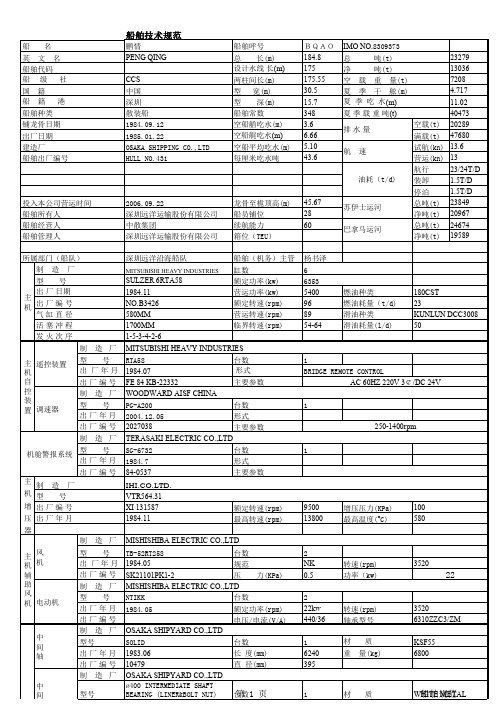
MISHISHIBA ELECTRIC CO.,LTD
NTIKK
台数
1984.05
额定功率(rpm)
电压/电流(V/A)
OSAKA SHIPYARD CO.,LTD
SOLID
台数
1983.06
长 度(mm)
10479
直 径(mm)
OSAKA SHIPYARD CO.,LTD
ø400 INTERMEDIATE SHAFT BEARING (LINER&BOLT NUT)
4 BLADES SOLID MAU TYPE 台数
1
1984.07.25
螺距
4558
TP.NO.81224
直 径(mm)
6300
型号
出 厂 日期 主 机 出厂编号
气缸直径
活塞冲程
发火次序
制 造厂
主 遥控装置 机 自 控 装 置 调速器
型号 出 厂年月 出厂编号 制 造厂 型号 出厂年月
出厂编号
制 造厂
机舱警报系统 型 号 出厂年月
出厂编号 主制 造 厂 机型 号 增 出厂编号
压 出厂年月
器
制 造厂
主风 机机 辅 助 风 机 电动机
BQAO 184.8 175 175.55 30.5 15.7 348 3.6 6.66 5.10 43.6
45.67 28 60
IMO NO.8309373
总
吨(t)
23279
净
吨(t)
13036
空 载 重 量(t)
7208
夏 季 干 舷(m)
4.717
夏 季 吃 水(m)
11.02
夏 季 载 重 吨(t)
2万吨船舶参数
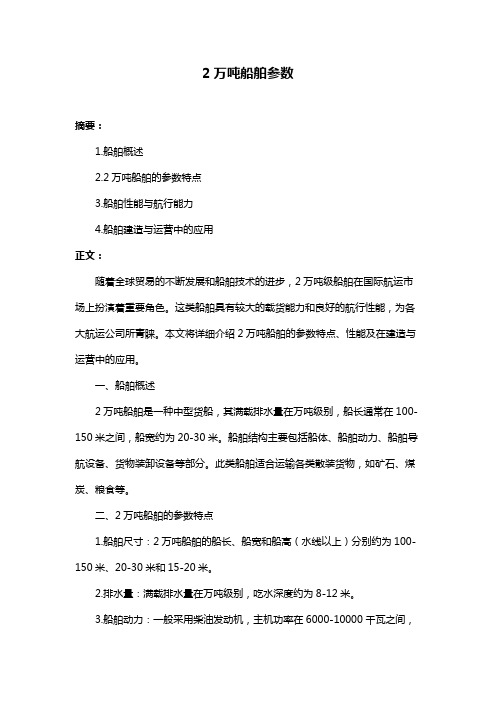
2万吨船舶参数摘要:1.船舶概述2.2万吨船舶的参数特点3.船舶性能与航行能力4.船舶建造与运营中的应用正文:随着全球贸易的不断发展和船舶技术的进步,2万吨级船舶在国际航运市场上扮演着重要角色。
这类船舶具有较大的载货能力和良好的航行性能,为各大航运公司所青睐。
本文将详细介绍2万吨船舶的参数特点、性能及在建造与运营中的应用。
一、船舶概述2万吨船舶是一种中型货船,其满载排水量在万吨级别,船长通常在100-150米之间,船宽约为20-30米。
船舶结构主要包括船体、船舶动力、船舶导航设备、货物装卸设备等部分。
此类船舶适合运输各类散装货物,如矿石、煤炭、粮食等。
二、2万吨船舶的参数特点1.船舶尺寸:2万吨船舶的船长、船宽和船高(水线以上)分别约为100-150米、20-30米和15-20米。
2.排水量:满载排水量在万吨级别,吃水深度约为8-12米。
3.船舶动力:一般采用柴油发动机,主机功率在6000-10000千瓦之间,船舶航速约为12-18节。
4.货物装载能力:2万吨船舶的货物装载能力约为1.5-2.5万吨,可根据货物类型和运输需求进行调整。
5.船舶导航设备:配备全球卫星导航系统、雷达、自动识别系统等先进设备,确保船舶安全、高效地航行。
三、船舶性能与航行能力2万吨船舶具有较好的航行性能和稳定性,适应不同海况。
其船舶设计采用先进的节能技术,降低能耗,提高船舶续航能力。
在航行过程中,船舶可实现自动化操控,降低船员疲劳度,提高航行安全性。
此外,船舶具有较强的抗风能力和载货能力,可适应多种货物运输需求。
四、船舶建造与运营中的应用1.船舶建造:我国船舶制造企业在建造2万吨船舶方面具有丰富经验,采用现代化造船工艺,确保船舶质量和性能。
2.船舶运营:2万吨船舶广泛应用于国内外航运市场,运输散装货物。
航运公司可通过合理规划航线、提高船舶利用率,实现盈利。
总之,2万吨船舶作为一种具有较高实用性的中型货船,在国际航运市场上具有广泛的应用前景。
豪华游艇全船技术规格书

目录第一章总则1.1 概述1.2 总体要求1.3 建造标准及规范1.4 设计要求1.5 图纸与文件资料1.6 材料和设备1.7 建造期间的检验1.8 下水和进坞1.9 检验和试验1.10交船1.11船厂责任1.12铭牌和识别第二章船体部分2.1 概述2.2 材料2.3 工艺2.4 切割与焊接2.5 船体结构2.6 舱柜2.7 舱口和人孔2.8 扶梯2.9 栏杆和扶手2.10花钢板2.11护舷设施第三章舱室布置、舱室主要设备、木作绝缘、家具及门、窗等3.1 舱室布置3.2 舱室主要设备3.3 木作绝缘3.4 家具3.5 门、窗等第四章船体保护4.1 概述4.2 涂装4.3 油漆表4.4 构件颜色分类和标记4.5 阴极保护第五章轮机5.1 总则5.2 主机5.3 齿轮箱5.4 柴油发电机组5.5防污染设备5.6泵5.7甲板机械5.8空调与通风5.9压缩空气5.10锅炉5.11轴系第六章管系及安装6.1 概述6.2 舱室管系6.3 主、辅机冷却系统6.4 燃油系统6.5 滑油系统6.6 废油系统6.7 排气系统6.8 压缩空气系统6.9 生活日用海、淡水、热水系统6.10消防、压载、舱底管系6.11透气、测量、注入系统6.12蒸汽管系6.13通风系统6.14隔热第七章电气部分7.1 概述7.2 配电系统7.3 电源设备7.4 配电设备7.5 控制设备7.6 照明电路7.7 空调及生活电器7.8 内部通讯设备7.9 无线电设备7.10航行设备7.11甲板机械7.12电线电缆第八章甲板机械和舾装8.1 锚泊装置8.2 系泊装置8.3 辅助设备第九章安全和航行设备9.1 通则9.2 救生设备9.3 火警警报和灭火装置9.4 航行设备第十章备件和工具第十一章安装、调试与验收第一章总则1.1 概述1.1.1 本技术规格书主要叙述海河豪华游艇的设计、建造及其所用材料、装备、检验、下水、试航、交船的规定。
1.1.2 本技术规格书是建造合同不可分割的一部分。
船舶规范详解

Length B.P. 型长:____181.80_M
Speed(Max/Service) 船速(最大/营运):_12KT
Breadth 船宽:_____28.39______M
Description of Bunker 燃料种类:_IFO 180cst /MGO
Depth 型深:__15.60_____ M
10289.8
9665.0
20
4
19.9×14.4
10315.8
9704.6
20
5
19.9×14.4
9802.6
9372.8
Cargo Capacity 总散装容积
49254.8
46673.2
Net Tonnage 净顿:___13424_MT__ Draft Laden (SUMMER/WINTER) 满载吃水(夏季/秋季):11.183 / 10.95M Draft Light 空船吃水:__6.52_______M
Call Sign 呼号:
Built When 建造时间:_1983 年
甲板层(DECK):单层(Single)
Hatch Size 舱别
1
L.X.B(M) 货舱尺寸
L.xB(M) 舱口尺寸 19.9×14.4
Crain M³ 散装容积
8652.8
Bale M³ 包装容积
8236.4
Crane 吊杆(T)
20
2
19.9×14.4
10193.8
9694.4
20ห้องสมุดไป่ตู้
3
19.9×14.4
Where 建造地点:_韩国(KOREA) Length O.A.全长:_190.15_M
18500DWT 散货船技术规格书
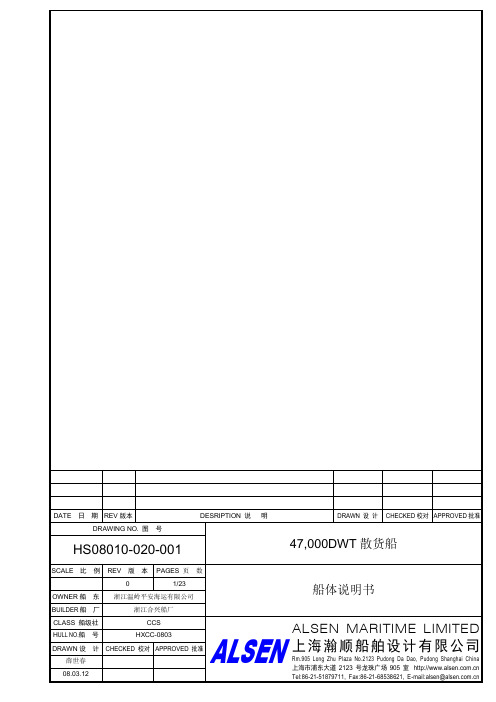
目录1总体 (5)1.1概述 (5)1.2主要参数 (5)1.3舱容 (5)1.4适用规范、法规及公约 (6)1.5船级及船旗国 (7)1.6航区 (7)1.7干舷 (7)1.8吨位 (7)1.9证书 (7)1.10载重吨 (7)1.11航速及续航力 (7)2性能 (8)2.1稳性 (8)2.2适航性 (8)2.3操纵性 (8)3总布置 (8)3.1底舱 (8)3.2距基线8.0M平台 (9)3.3机舱上平台 (9)3.4上甲板 (9)3.5艏楼甲板 (10)3.7B甲板 (10)3.8C甲板 (10)3.9桥楼甲板 (11)3.10罗经甲板 (11)4船体结构 (11)4.1概述 (11)4.2船体材料 (11)4.3船体局部强度 (11)4.4结构形式 (11)4.5主要构件尺寸 (11)5甲板机械 (15)5.1电动液压起锚机 (15)5.2舵机 (15)5.3电动液压系泊绞车 (15)5.4救助艇/食物吊 (16)5.5抛落式救生艇 (16)5.6舷梯绞车 (16)6舾装设备 (16)6.1锚泊设备 (16)6.2系泊设备 (17)6.3舵设备 (17)6.4金属门、窗、盖 (17)6.6救生设备 (19)6.7消防设备 (20)6.8桅墙设备 (20)6.9防蚀装置 (20)7舱室舾装 (20)7.1防火结构 (20)7.2甲板敷料 (20)8涂装及防腐措施 (20)8.1总则 (21)8.2涂装 (21)9内部舾装 (22)9.1家俱 (22)9.2洗衣间和烘衣间 (22)9.3食品冷库 (22)1 总体1.1 概述本船设计为一艘国内近海航行具有单层连续甲板和艏楼,单螺旋桨柴油机驱动的散货船,适用于运输散装货物,包括谷物、煤、铁矿石、钢卷板钢管等散杂货物。
包括驾驶室在内的整个居住处所和推进机械均位于艉部。
本船的主要特征和布置见“总布置图”。
本船由舱壁、甲板、双层底和平台分隔为下列处所和舱室:艉部:带有方艉的艉部设有船员住舱和桥楼、自肋位#-5~#8设有舵机舱、艉尖舱、淡水舱、艉管冷却水舱和储藏室等。
18000DWT船体说明书
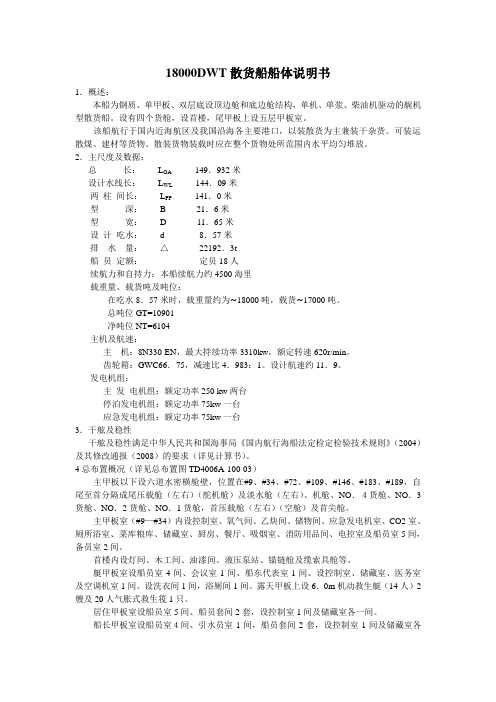
18000DWT散货船船体说明书1.概述:本船为钢质、单甲板、双层底设顶边舱和底边舱结构,单机、单浆、柴油机驱动的艉机型散货船。
设有四个货舱,设首楼,尾甲板上设五层甲板室。
该船航行于国内近海航区及我国沿海各主要港口,以装散货为主兼装干杂货。
可装运散煤、建材等货物。
散装货物装载时应在整个货物处所范围内水平均匀堆放。
2.主尺度及数据:总长:L OA 149.932米设计水线长:L WL 144.09米两柱间长:L PP 141.0米型深: B 21.6米型宽: D 11.65米设计吃水: d 8.57米排水量:△22192.3t船员定额:定员18人续航力和自持力:本船续航力约4500海里载重量、载货吨及吨位:在吃水8.57米时,载重量约为~18000吨,载货~17000吨。
总吨位GT=10901净吨位NT=6104主机及航速:主机:8N330-EN,最大持续功率3310kw,额定转速620r/min。
齿轮箱:GWC66.75,减速比4.983:1。
设计航速约11.9。
发电机组:主发电机组:额定功率250 kw两台停泊发电机组:额定功率75kw一台应急发电机组:额定功率75kw一台3.干舷及稳性干舷及稳性满足中华人民共和国海事局《国内航行海船法定检定检验技术规则》(2004)及其修改通报(2008)的要求(详见计算书)。
4总布置概况(详见总布置图TD4006A-100-03)主甲板以下设六道水密横舱壁,位置在#9、#34、#72、#109、#146、#183、#189,自尾至首分隔成尾压载舱(左右)(舵机舱)及淡水舱(左右)、机舱、NO.4货舱、NO.3货舱、NO.2货舱、NO.1货舱,首压载舱(左右)(空舱)及首尖舱。
主甲板室(#9—#34)内设控制室、氧气间、乙炔间、储物间、应急发电机室、CO2室、厕所浴室、菜库粮库、储藏室、厨房、餐厅、吸烟室、消防用品间、电控室及船员室5间,备员室2间。
首楼内设灯间、木工间、油漆间、液压泵站、锚链舱及缆索具舱等。
- 1、下载文档前请自行甄别文档内容的完整性,平台不提供额外的编辑、内容补充、找答案等附加服务。
- 2、"仅部分预览"的文档,不可在线预览部分如存在完整性等问题,可反馈申请退款(可完整预览的文档不适用该条件!)。
- 3、如文档侵犯您的权益,请联系客服反馈,我们会尽快为您处理(人工客服工作时间:9:00-18:30)。
23800吨散货船技术规格书1.总则1.1 本船轮机部分技术设计按23800DWT货船设计任务书要求,并满足法国船级社(BV)《钢质船舶入级规范》有关要求以及其他有关国际航行船舶的政府规定。
1.2 本船推进装置型式为单机单桨,主机为低速二冲程柴油机经中间轴和尾轴直接传动螺旋桨。
1.3 本船主要装载煤炭等大宗杂货。
1.4本船各机械设备及管系附件均按中国工业标准(如GB、CB、JB、YB等)制造,但进口设备附带的附件及管系等按制造厂标准。
1.5各机械设备的备品供应按船级社规范和船东要求配置。
1.主要设备的配置2.1 主机 1台型号:MAN-B&W 7S35MC型式:二冲程,单作用涡轮增压,直流扫气,十字头式,可直接换向船用柴油机缸数:6缸径/行程:350/1400mm最大持续功率(MCR):5180kW转速:173r/min燃油消耗率:178g/kW·h+5%起动方式:压缩空气(最大压力2.94MPa)2.2主柴油发电机组 3组机组型号:CCFJ465J2.2.1 柴油机型号:MAN-B&W 5L16/24型式:直列,四冲程,直接喷射增压中冷船用柴油机缸数:5缸径/行程:160/240mm额定转速:1200r/min燃油消耗率: 189g/kW·h起动方式:压缩空气冷却方式:水冷2.2.2 发电机型号:1FC6 454-6型式:船用三相交流同步发电机额定功率:465kW额定转速:1200r/min电压:450V频率:60Hz2.3 应急柴油发电机组 1组机组型号:CCFJ120Y-W6额定功率:120kW电压:450V频率:60Hz2.4 燃油/废气组合锅炉型号:LZY0.8/140-0.7蒸汽压力:0.7Mpa蒸发量:燃油部分: ~800kg/h废气部分: ~650 kg/h注:2台锅炉给水泵由锅炉厂配套供应3 轴系3.1本船主机为刚性固定,采用环氧树脂垫块进行安装。
轴系中心线平行于基线,距基线高2600mm。
主机输出经中间轴及尾轴直接驱动定螺距桨,螺旋桨轴与螺旋桨以及螺旋桨轴与可拆联轴节的联接为有键联接。
轴系长度可用调整中间轴长度来实现微调整。
中间轴处设有中间轴承及接地装置,并在轴上装有轴系转速装置。
螺旋桨轴前后轴承采用天龙高分子轴承,水润滑。
尾轴前端设水密封装置。
轴系拆除时,螺旋桨轴从船尾抽出。
3.2 轴系材料中间轴、螺旋桨轴均由优质碳素钢整锻制成,其材料的机械性能应满足规范要求4舱室布置(详见机舱布置图)4.1 机舱位置和布置本船机舱为尾机型,位于#10-#35肋位(肋骨间距为750mm)机舱长度18.75m,机舱型深14.2m,上甲板以下机舱设置底舱、机舱上下平台共三层,机舱下平台为7.1m,上平台为10.95m。
机舱花钢板高度距基线为3500mm。
4.2 机舱棚及烟囱布置在上甲板以上#10-#20肋位间和尾楼甲板#10-#17肋位设有机舱棚,其内布置有燃油/废气组合锅炉,在机舱棚的前端布置有主机淡水膨胀水柜和锅炉燃油柜、后端左右侧布置了通风管。
在船长甲板以上#10-#17肋位间为烟囱,设有三台辅机的消音器和排气管等。
4.3 应急发电机室设于尾楼甲板左舷#20-#27肋位间。
应急发电机室设有一台120kW应急柴油发电机组以及为应急发电机组服务的主要设备如轻柴油柜、配电板、压缩空气起动系统、电瓶、变压器等。
4.4 应急消防泵设于船艏#187-#194肋位间的舯部底层。
内设一台应急消防水泵,其排出管与机舱消防水总管连通。
在舱内设有专门海底阀,舱内舱底泄水由喷射泵抽逐从锚链筒排出舷外。
舱内装有一只消火栓供舱内消防用。
5动力管系5.1 燃油管系本船在海上航行时,主机和柴油发电机组用1500sec.RWI重燃油,但在起动、进出港等工况时使用轻柴油。
锅炉和应急柴油发电机组使用轻柴油。
燃油管系由三部分组成:即燃油注入与输送、燃油的净化和燃油供给,并有相应的燃油应急快速关闭装置和燃油泄放。
5.1.1 燃油的注入与输送本船重燃油和轻柴油分别由艉楼甲板左右两舷的注油口,利用外界输送泵注入,当注油出现溢油时,则自动溢入重燃油、轻柴油溢油舱。
本船设有2台重燃油输送泵,其排量18 m3/h、压力0.36MPa;另设2台轻柴油输送泵,其排量为5m3/h、压力为0.33MPa,输送泵前均设置吸入滤器。
燃油舱的油通过燃油输送泵驳运,轻柴油舱的油通过轻柴油输送泵驳运,每种燃油泵常用1台,备用1台。
燃油输送泵可按需要将各燃油舱的油驳至燃油沉淀舱,轻柴油输送泵可将轻柴油储存舱内的轻柴油输送至轻柴油日用舱。
燃油舱柜均设置自闭式泄放阀。
燃油沉淀舱、日用舱及轻柴油的日用舱都设有溢油管溢油至各自的溢油舱内。
各燃油舱柜均装设液位表,燃油和轻柴油的日用舱、沉淀舱和深油舱设浮子式液位计。
本船还设有一台油渣泵,可把油渣舱中的渣油排至标准接头。
5.1.2 燃油的清理与净化为了满足柴油机对燃油品质的要求,重燃油应除去杂质和水分。
所以系统中除通过过滤及沉淀等清理工作外,还采用二台燃油分油机进行分离净化。
重燃油在沉淀舱内沉淀后进入分油机,通常情况下燃油有一台分油机进行分离,另一台分油机通常情况下为备用,当燃油需二次净化时,此台分油机可投入工作;分油机单元配有高置水箱和油加热器,以提高分油效果。
分离出的油渣和水,分别排入燃油油渣舱和污水舱内,净油分别进入燃油日用舱。
燃油溢油舱的油经燃油输送泵输送至燃油沉淀舱,该舱内的油再经分离处理后,供主机使用。
5.1.3 燃油供给与泄放主机和主发电机组通过一台燃油供应单元供给燃油。
燃料油管需敷设蒸汽伴行管,并外包绝热材料。
燃料油沉淀舱、燃料油日用舱设蒸汽加热盘管加热,并设油舱温度计,人工控制蒸汽量。
5.1.4 燃油快速关闭装置各燃油舱柜设有应急快关阀,机舱里的为气动,应急柴油日用柜的为手拉钢丝式,遥控操作装置应放在便于操作和人易到达的地方。
来自本系统各油舱柜、油泵、滤器及甲板注入口等油盘中的残油,可先泄放至废油舱,该舱内的油经分离后可重新使用。
5.2 滑油管系滑油管系是对本船动力装置设备供应足够的合乎质量要求的滑油。
主机油底壳为干式,其滑油系统由滑油泵(2台,其中1台为备用)、机油滤器、机油冷却器等组成,滑油自成系统;主机下设有滑油循环舱,由滑油泵将循环舱内滑油泵入机内各处进行润滑和冷却。
付机采用湿式油底壳润滑方式,滑油泵装于机身上,成独立系统。
5.2.1 滑油的注入、输送主、付机滑油由尾楼甲板滑油注入口由船外输送泵注入滑油储存舱。
滑油储存舱内滑油可靠重力流至主机滑油循环舱,主副机滑油舱柜上均装有自闭式平板液位计,主机滑油循环舱装有测深和低位报警装置。
5.2.2 滑油的清理与净化为了满足柴油机对滑油质量的要求,系统中除通过过滤及沉淀等清理工作外,还设有滑油分油机,对主机滑油循环舱和主发电机组油底壳中的滑油进行分离处理,也可将储存舱内的滑油进行分离净化,然后将净油输送至滑油循环舱。
分离出来的杂质和水均由人工排放至油渣舱,由油渣泵排出。
5.2.3滑油泄放机舱中各种滑油设备,包括双层底以上的各滑油舱柜、油泵、滤器以及甲板上注油口等处均应设置油盘,并用管子将油盘中残油引至污滑油舱。
5.3 冷却水管系主、付机均为闭式冷却。
淡水在淡水冷却器中由海水冷却。
系统由主机电动海水泵(2台,其中1台为备用)、电动淡水泵(2台,其中1台为备用)、主机冷却器和淡水膨胀水箱、副机电动海水泵、副机机带淡水泵及管路等组成。
5.3.1 海水冷却管系主机冷却用的海水由主机电动海水泵从海水总管吸水后泵出,经中冷器、滑油冷却器、淡水冷却器后排至舷外;付机冷却用一台电动海水从海水总管吸水后泵入,冷却付机后排出舷外。
另设付机海水备用泵一台,当付机海水泵发生故障时可替代工作。
5.3.2 淡水冷却管系主机淡水经淡水冷却器冷却后由主机电动淡水泵供水进机,当其不能工作时,由主机淡水备用泵供水。
当主机冷却水从出水总管排出后,即进入淡水冷却器冷却后再进机,循环使用。
在淡水冷却器进出口之间装有自动调温器来调节淡水温度。
主机设有一淡水膨胀水箱,该水箱有管路与主机淡水泵入口相连接,系统消耗的淡水由机舱淡水压力柜对膨胀水箱加以补充,主机淡水透气向上进入膨胀水箱,膨胀水箱设有低位报警。
在系统最低处设有放泄阀,泄水至舱底。
5.4 压缩空气系统本系统设有两台空压机,其排量82m3/h,压力3.0MPa,配置二只1500L主空气瓶,另配250L控制空气瓶一只,250L杂用空气瓶一只。
5.4.1 主机压缩空气起动系统主空气瓶可由任一台空压机充气。
空压机由压力继电器控制启动及停车,一台低于2.0MPa起动、3 MPa停止,另一台低于1.8MPa起动、3MPa停止。
空压机的压缩空气出机后经气水分离器去除水分后充入二只主空气瓶,再由主空气瓶向其它气瓶充气。
主空气瓶向主机提供3.0MPa压力的起动空气,二只主空气瓶的容量能保证主机在冷车工况下连续起动12次以上。
5.4.2 控制空气系统从主空气瓶出来的压缩空气经减压阀组减压到1MPa后向控制空气瓶充气,1MPa控制空气再减压至0. 7MPa后可直接通达需用控制空气的各设备处。
从控制空气瓶出来的空气必需经空气干燥器干燥后方可使用。
5.4.3 杂用空气系统杂用空气瓶可供气笛用压缩空气和供全船杂用,然后减压至0.4MPa后供各压力柜充气和供各海水门吹洗之用。
5.4.4在机舱外处所,还装有气动式速闭阀控制箱,以便对双层底以上各燃油和滑油舱柜上的气动速闭阀进行遥控关闭。
5.5 排气管系本船排气管由一台主机、三台付机一台燃油废气组合锅炉的排气管路组成。
主机和付机排气出口管路上均装有不锈钢波形膨胀节,主机排气管路上设有燃油/废气组合锅炉一台(废气部分蒸汽量~650kg./h,压力0.7MPa)。
各排气管路相互独立,互不干扰。
各付机排气管上均装有消音器,并在排气管弯头的最低处设有泄水管路泄至舱底。
各排气管的适当管段装有弹性吊架,并在各管路通过烟囱顶板处设置甲板弹性导管,以适应管路因温度变化而引起的伸缩移位。
排气管外均需包覆隔热层,设备运行时表面温度应不大于60℃。
5.6 锅炉蒸汽给水、凝水和舱柜加热管系本系统由一台燃油/废气组合锅炉,一台热井及大气冷凝器单元及二台供水泵组成。
其功能是产生蒸汽,供如下设备加热及保温使用:1) 供主机的燃油舱、燃油沉淀舱和燃油日用舱加热保温。
2) 供燃、滑油分油机加热器加热。
3) 供燃油溢油舱、污油舱和油渣舱加热。
4) 供主机燃油/供油单元加热。
多余的蒸汽经过蒸汽排放装置进大气冷凝器冷却后的水回到热井,经供水泵输送进入锅炉加热。
6 全船管系6.1 舱底、压载、消防管系6.1.1根据规范要求,本船设有独立的舱底水泵二台(1台为总用泵),该两泵均具有自吸能力,可抽取各舱内的水。
